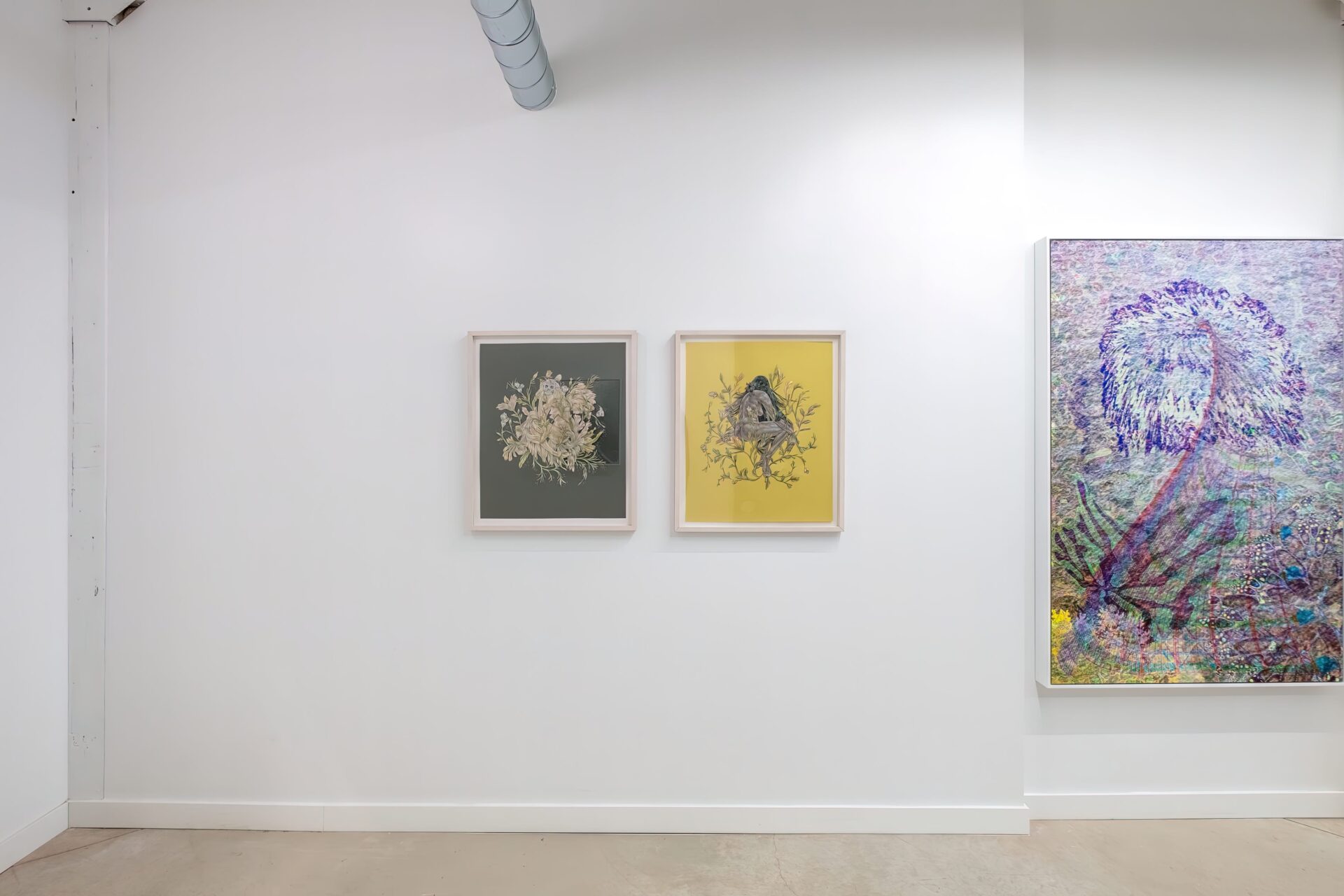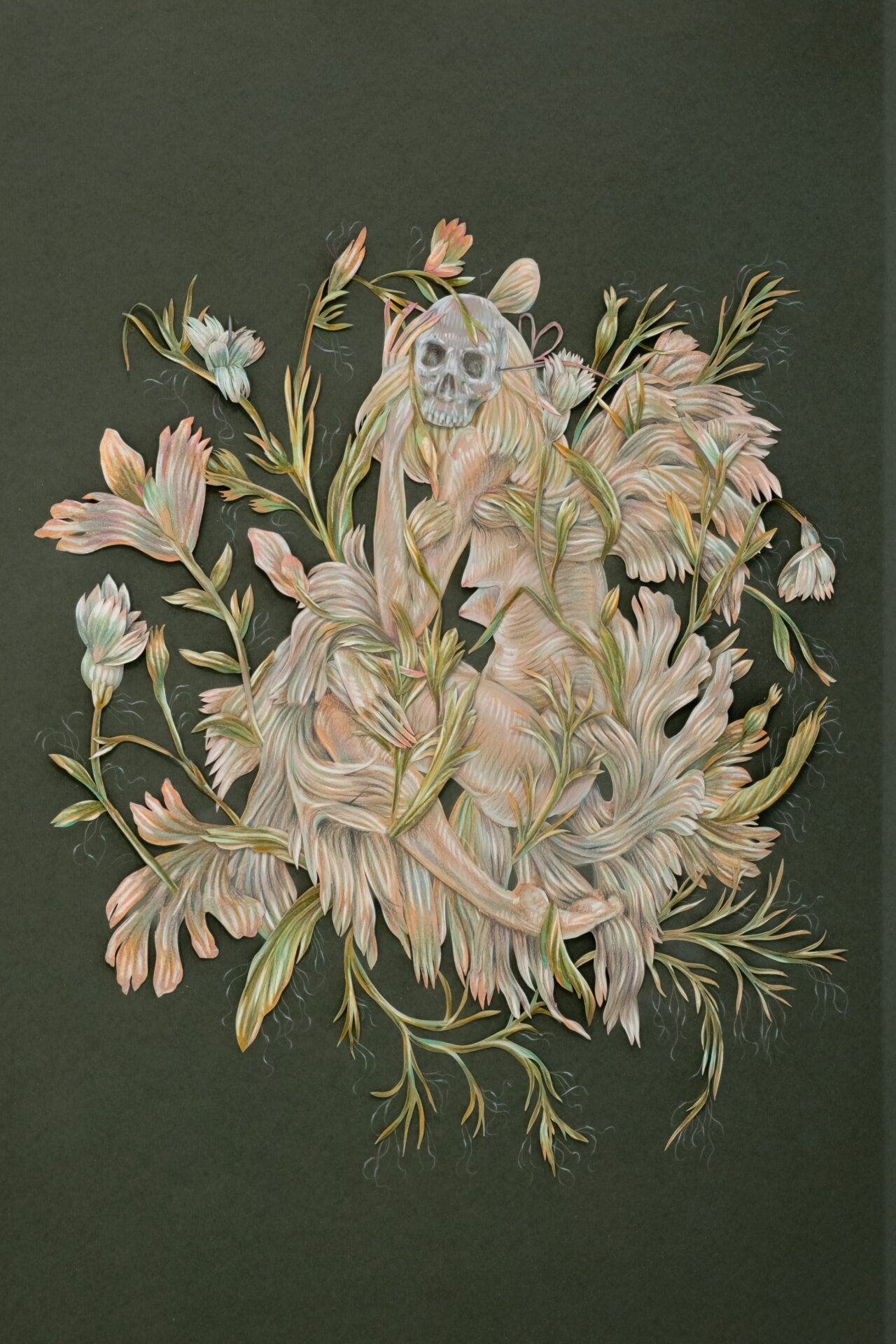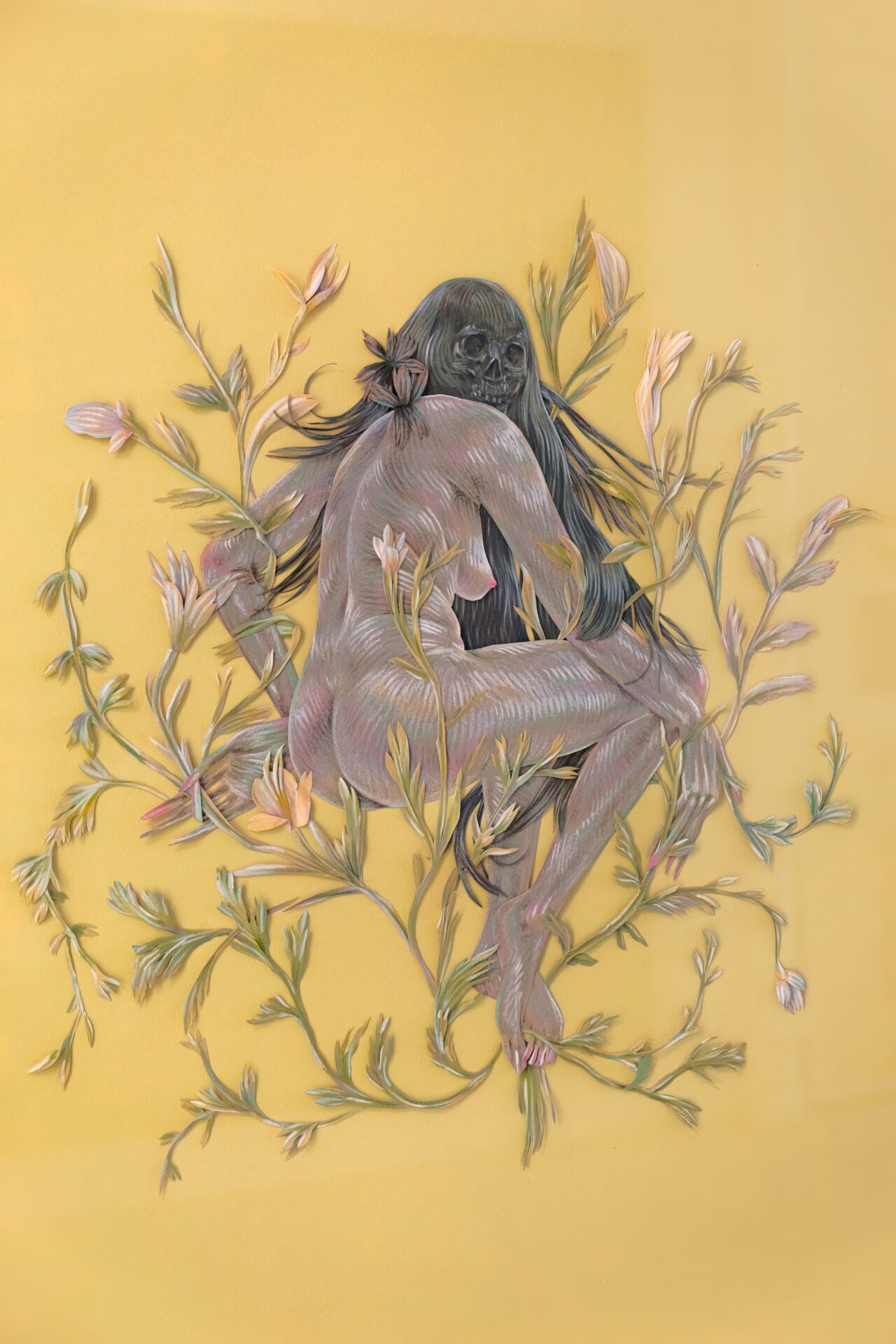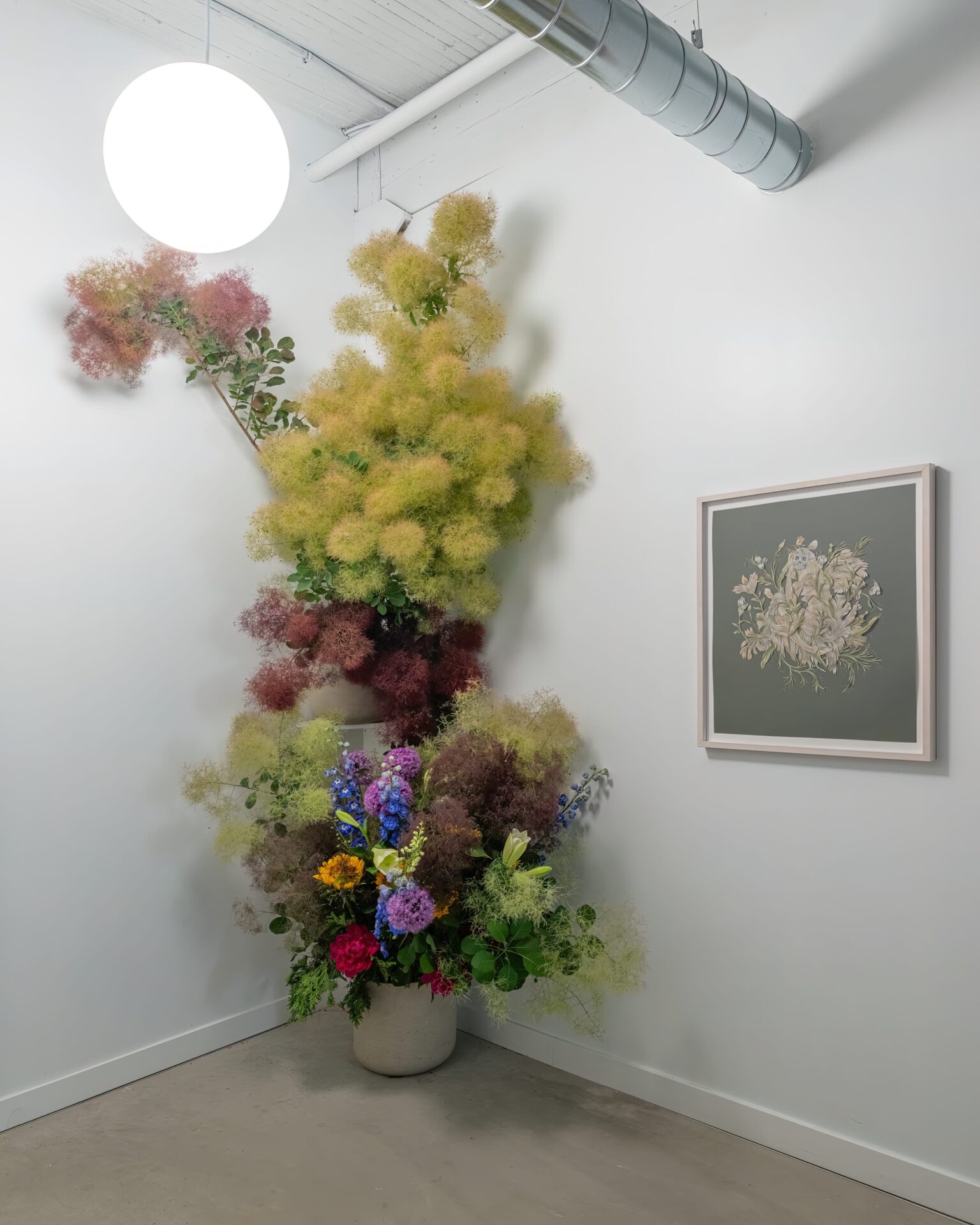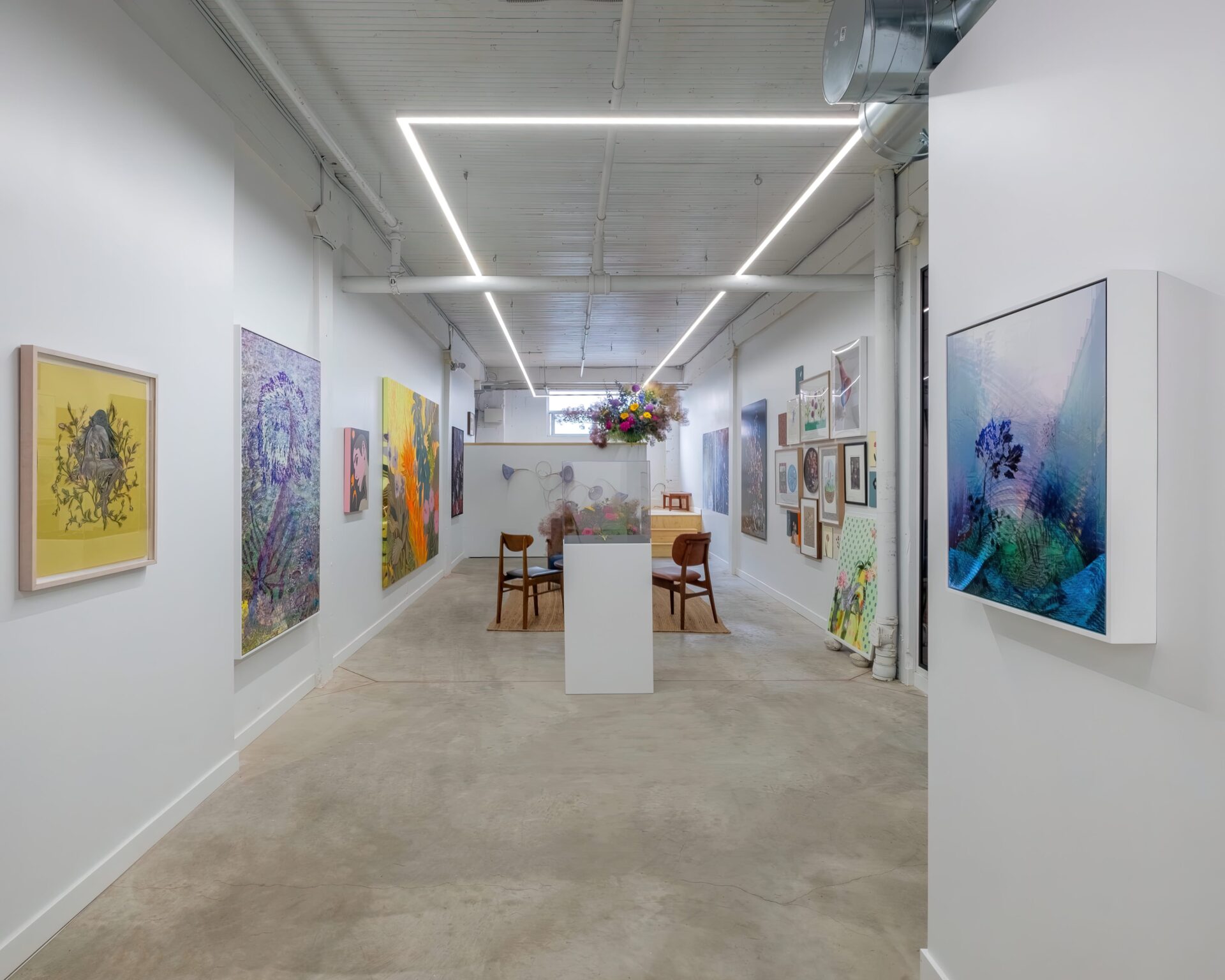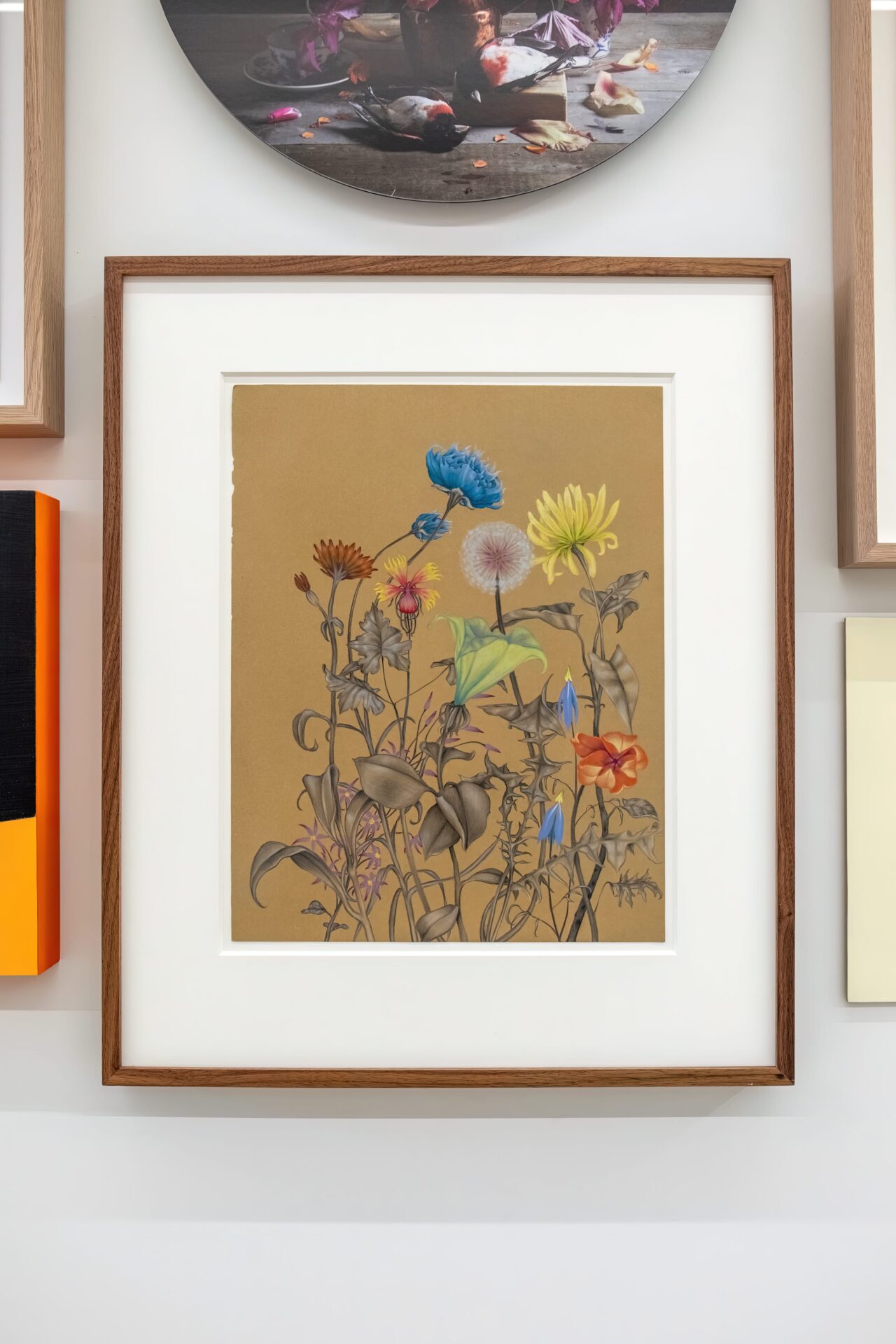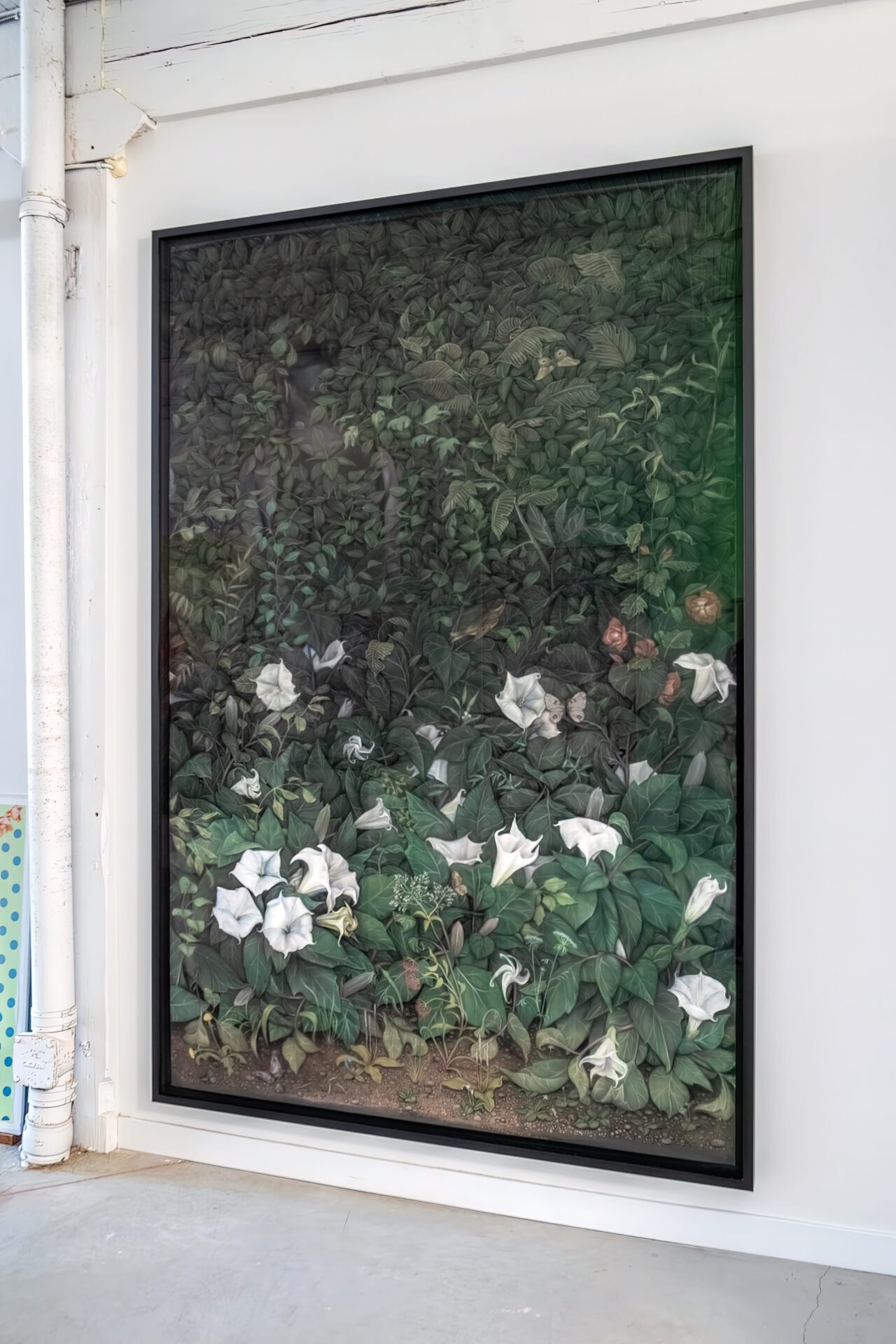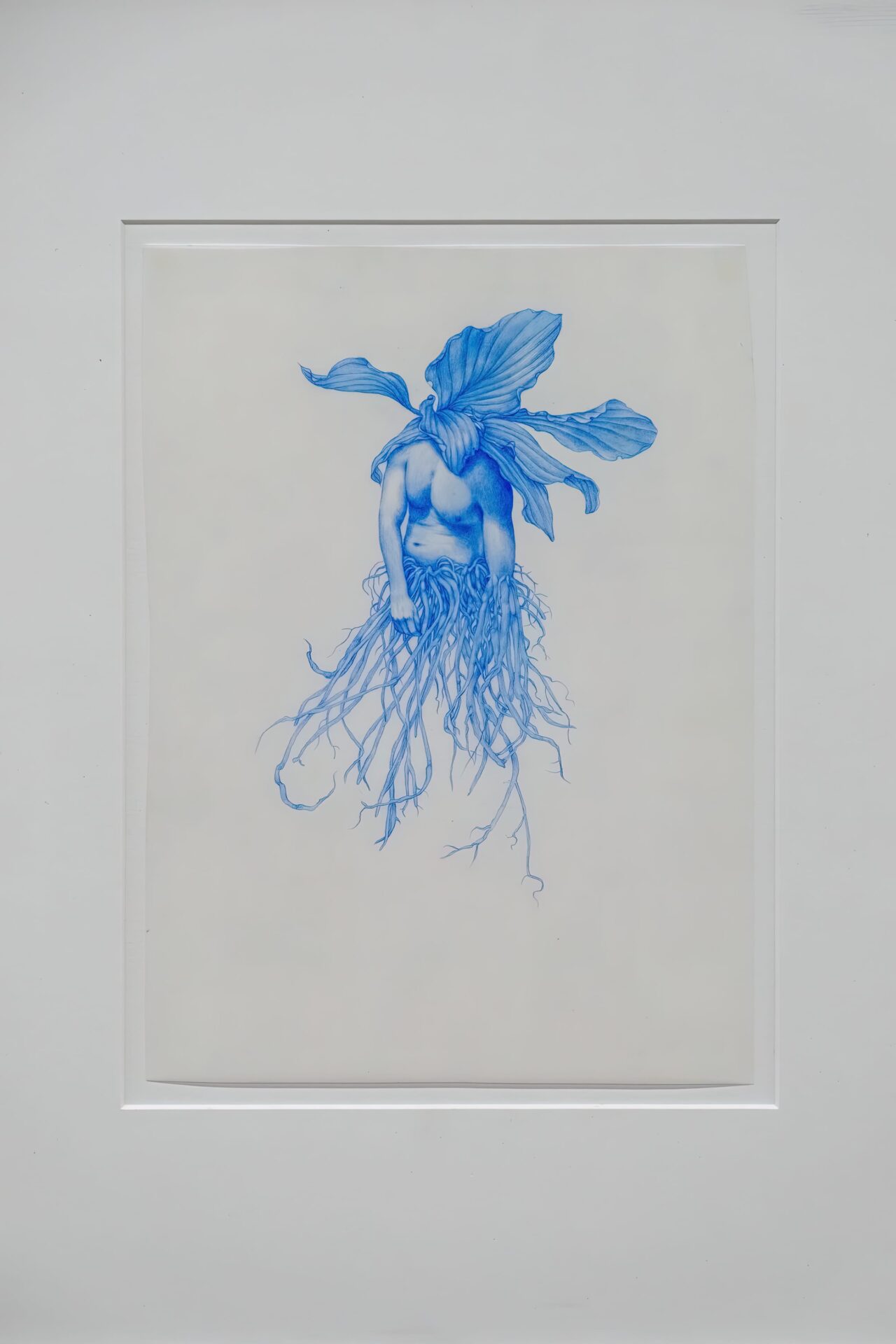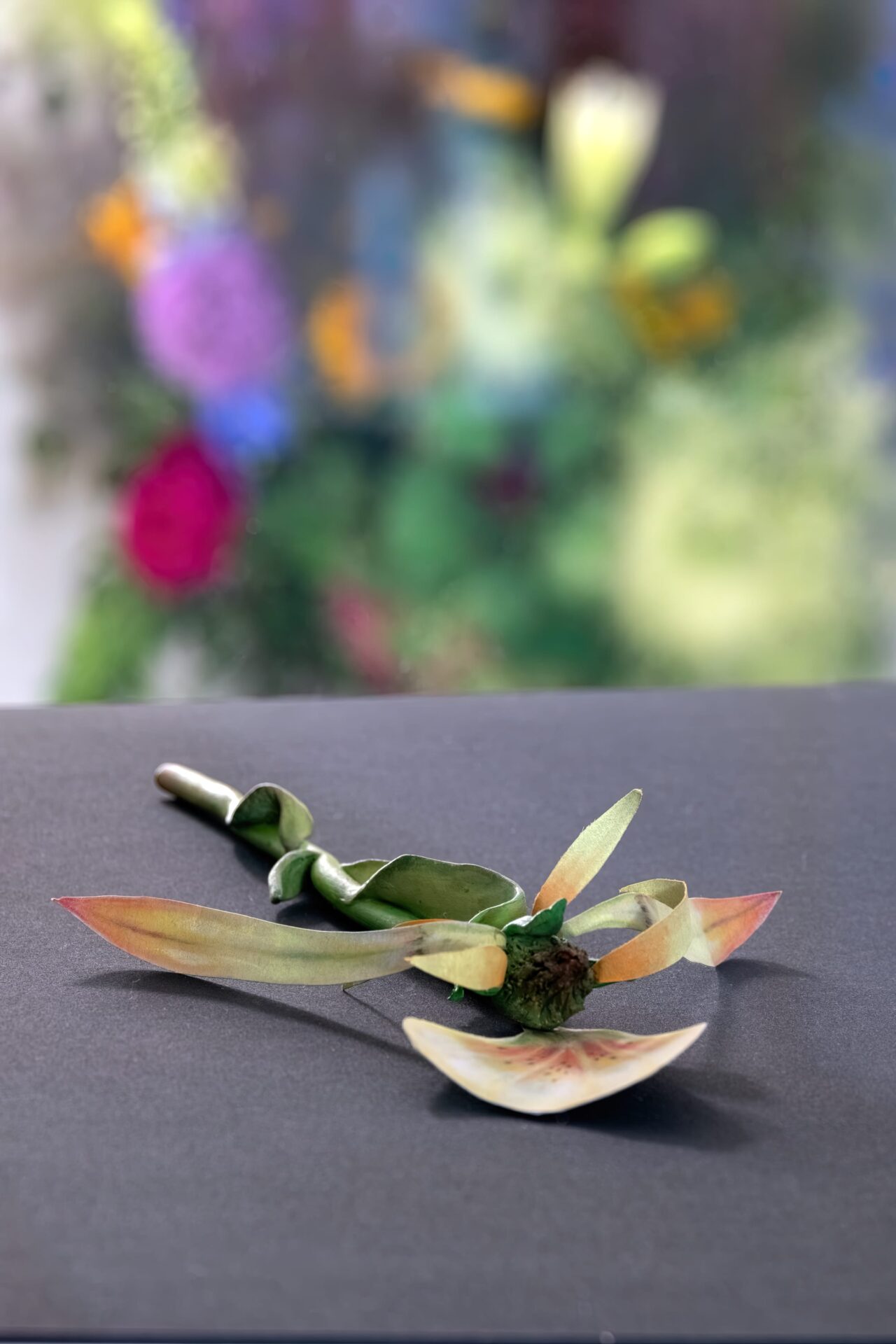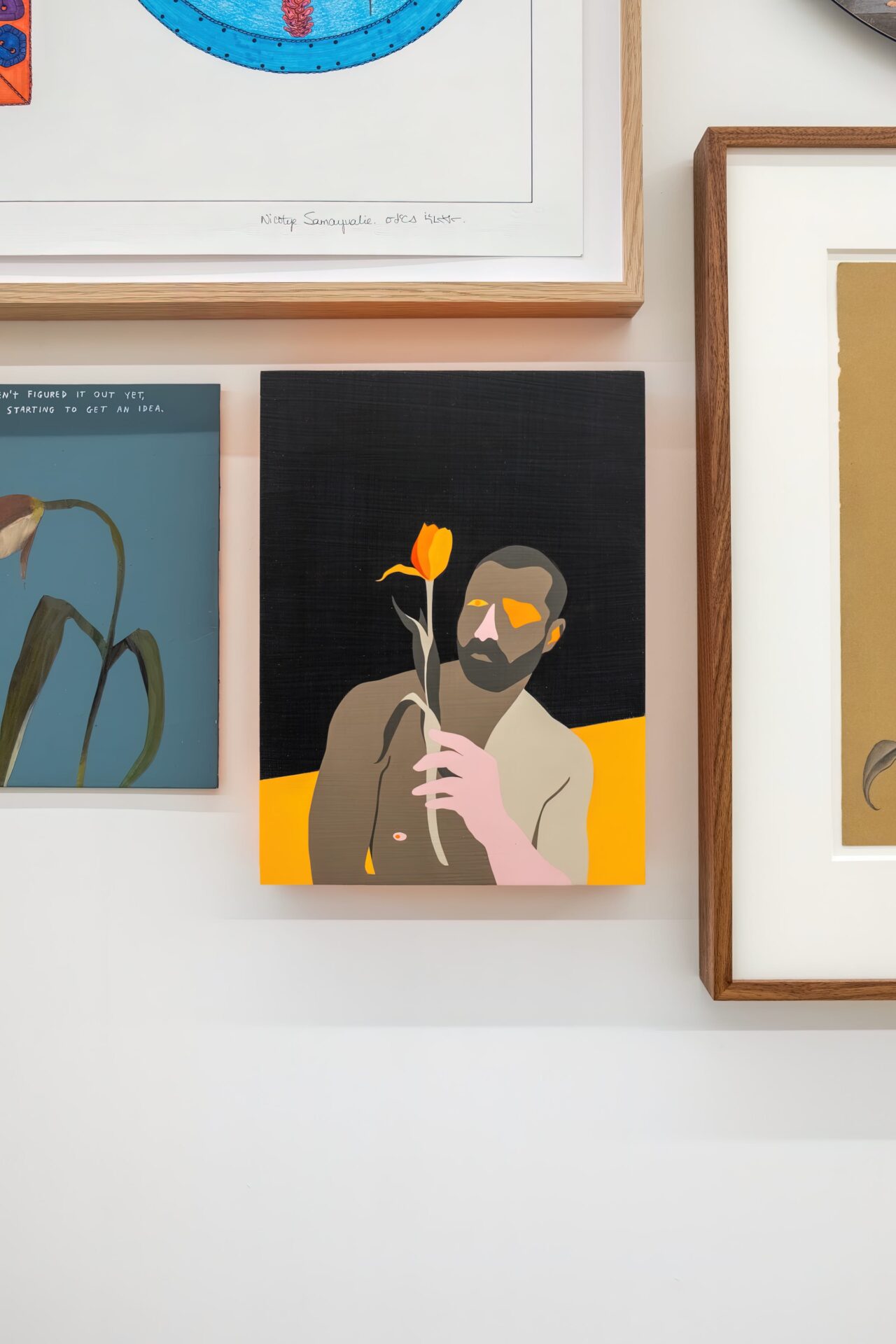Giving Entry
Curated by NAMARA | projects Curator, Natalie MacNamara
an exhibition of works by
Michael Dumontier + Neil Farber, Alex Fischer, Nelson Henricks, Rick Leong, Zachari Logan, Terran McNeely, John Monteith, Janet Morton, Dainesha Nugent-Palache, Nicotye Samayualie, Kristin Sjaarda, Winnie Truong, Emma Welch, Xiaojing Yan
July 9 — September 10, 2022
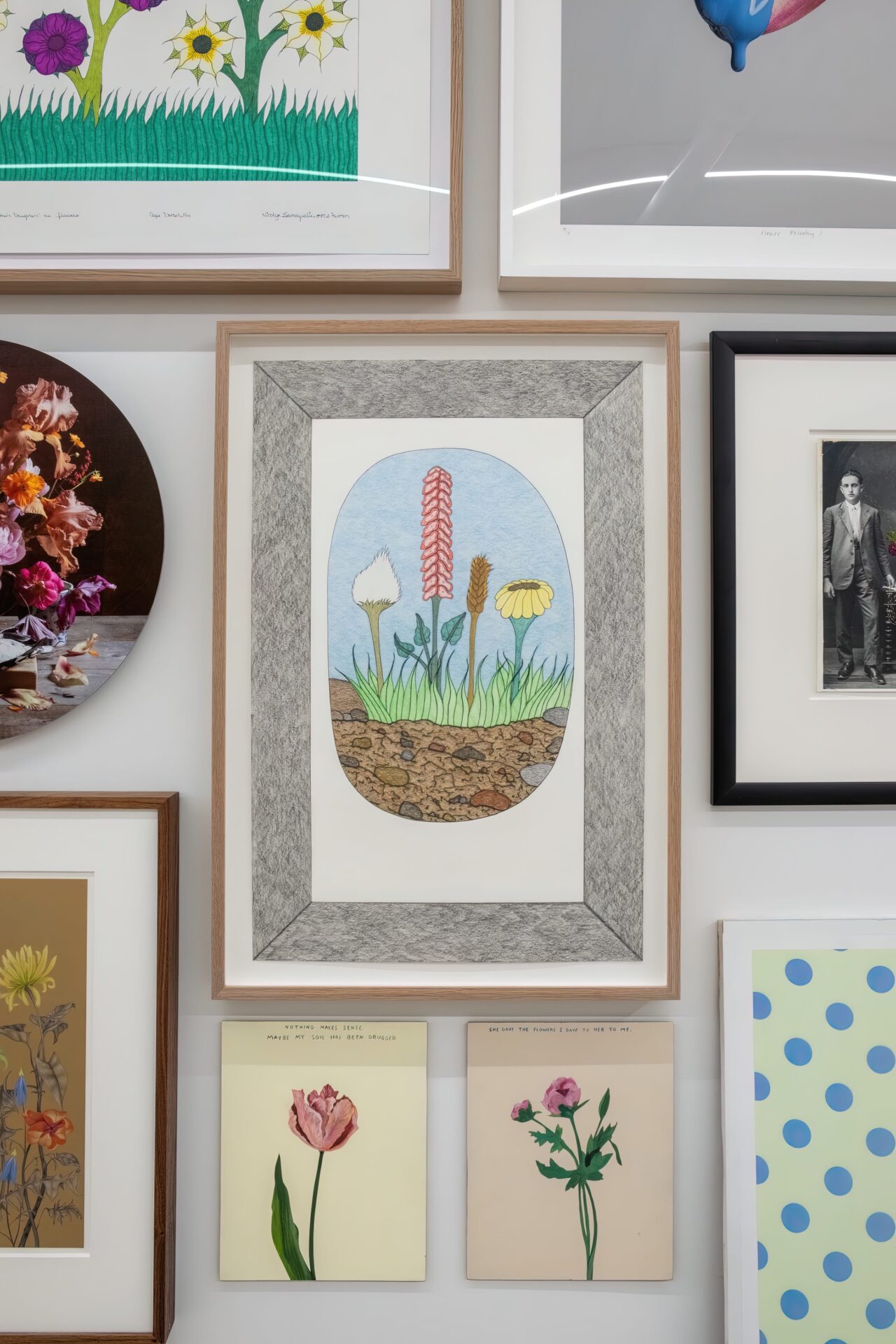
Giving Entry is an exhibition of works by artists who employ flowers or floral motifs in considerations of social, philosophical, and political subjects. What matters most is the embeddedness of these blooms in their particular stories. Within this exhibition, flowers are put to work symbolically in varied artistic inquiries. Counting among them are built narratives around equality and difference; history, memory, and temporality; environment and climate; speculation and the supernatural.
Select works are available for sale in partnership with artists and their representation. Gratitude to Bradley Ertaskiran, Patel Brown Gallery, Paul Petro Contemporary Art, Dorset Fine Arts, and to all exhibition artists for your collaboration and support.
Letter of Curatorial Intent
Natalie MacNamara
Principal & Creative Director, NAMARA
It is my pleasure to welcome you to this new Project Space. It is an extension of NAMARA, a curatorial firm that I have operated since 2015. As a company, we work around the fluctuating borders of the traditional art world, bringing together artists and art professionals with commercial organizations. My purpose for the Space is to conduct research through practice; and to learn through and with other curators who will present exhibitions. I believe that curators from the traditional art world are necessary when the art sphere crosses into commercial spaces. We are uniquely positioned to apply scrutiny to commercial projects, ensuring that artists and brands benefit equally when art is rendered purposeful.
For the first exhibition and launch of the space, I offer Giving Entry, a selection of artworks that employ flowers and floral motifs in considerations of social, philosophical, and political subjects. Gifting flowers has been a tradition since time immemorial. Blooms are typically useless, inedible, decorative. Like art, flowers need not be more than what they are. The reward of receiving flowers is not a material one. Gifting flowers is a tradition that triggers emotion and memory among givers and receivers, alike. What matters most is their embeddedness in a story. Gifting Flowers is Giving Entry into those narratives. Like art, flowers are attributed with meaning, symbolizing love, friendship, celebration, memorial, and mourning. Flowers can be understood universally and for this reason, they are sometimes viewed as trivial, but the assembled works reward viewers for their steadied consideration with opportunities for discovery.
Group exhibitions narrow focus, often to the unfortunate exclusion of artists’ purposes, ambitions, intentions, or investigations. This presentation is no exception, but I hope that new or thoughtful points of connection make up for these intervals. To offer a list of works with brief descriptions is a practice of omission. Each artist is wrestling with ideas too layered or nuanced to be represented in such a brief text but I hope that by bringing some works together I am adding to each artist’s rich exploration and not reducing their work to a single interpretation. While I offer some of the connections that have become meaningful through the curatorial process, I encourage the viewer to also engage with the artists’ own biographies and statements.
Zachari Logan’s layered pastels, drawings, and ceramics often elevate domestic flowers and even weeds in intricate yet monumental compositions. Flora is often sourced from road-side ditches–sites on the margins where nonconformity and resistance flourish through neglect. Logan’s visual language that questions notions of masculinity tethers to Terran McNeely’s portraits, painted with a contrasting graphic sensibility. Gentle postures and decorative flowers subvert traditional notions of maleness, asserting that men can be vulnerable and gentle. McNeely’s portraits are equal parts assertions and invitations toward tenderness. Winnie Truong’s paper cut-outs interrogate femininity, feminism, and fantasy. Limbs extend into leaves and petals. The figures lean away from the viewer while confronting us head-on with skull-masks. If Logan and McNeely are suggesting a softer masculinity, Truong answers with manifest feminine aggression or darkness, barely concealed by the entangled textures of delicate flowers and long hair.
Alex Fischer postulates on art’s status in technological futures. Questions about ownership, mark-making, and identity are deliberated on through interpreted traditional genres of portraiture, landscape, and still life. His digitally rendered, layered compositions reveal and conceal simultaneously, with only the florals distinct among a breadth of referenced subject. Xiaojing Yan’s Morning Glory also considers time, but through Chinese material culture. Tensions are revealed between lightness and strength, ephemerality, and endurance in this representation of flowers that live for just one rotation of the sun. Considerations of time and temporality are maintained through John Monteith’s Untitled, (An Excerpt, Beijing). Quoitidien photographs, weathered and worn door frames and exterior walls read nearly as abstractions. Referencing issues related to temporality, ephemerality, and disappearance, the work considers memory and place through details of now demolished domestic dwellings and communities on the outer edges of Beijing. Fixations on memory persist into Dainesha Nugent-Palache’s A House Standing Where it Should Have Fallen. Nugent-Palache considers migration paths of both plants and people–How they persist despite incompatible climates, visualizing Black diaspora across time. The synthetic and natural come together in contemplations of family, history, and speculative futures.
Emma Welch stabilizes her flowers as patterns and screens. Floral motifs give entry to the space she describes as “field psychedelia.” The repeated image, suggesting a kind of ritual to attain altered states of consciousness. Meanwhile, Rick Leong presents a full, almost chaotic installation of plants and flowers in his large-scale painting. Flora is impossibly layered but varied, suggesting a domestic space–a greenhouse or biome. As with his work, depicting old growth forests in the Canadian west, the experience of nature is offered analogous to the museum or gallery experience–preserved, distanced, curated.
Kristin Sjaarda’s photographs take their departure from Dutch Golden Age painting. Her arrangements are photographed in Toronto, using local flora and ancestral objects passed down from her Dutch grandmother, past and present are a synchrony. As with Sjaarda’s work, medium foregrounds memory in Janet Morton’s practice. A meditation on loss, Morton intervenes with embroidered stitches–the whimsical gestures suggesting the dreams or imagined memories of unknown subjects. Art historical reference, process and the production of beauty are equally central in Nelson Henrick’s Flower Paintings. Performance-based actions result in a series of paradoxes–between violence and seduction, profession and hobby.
The shared practice of Michael Dumontier and Neil Farber marries word and image, reflecting on human experience. Humour and sadness figure equally. Solitary flowers are supported by suggestive lines of text. The result is a sense of candour, also intimated in Nicotye Samayualie’s drawn florals. Curious bunches of planted flowers are sometimes ornamented and framed, perhaps securing them in her memory. For both Dumontier and Farber, as well as Samayualie, floral depictions harken to childhood studies but worldly experience, pain and joy permeate the compositions–vulnerability and strength figure equally.
Zachari Logan — Biography
zachariloganart.com
Zachari Logan is a Canadian artist working mainly in drawing, ceramics and installation practices. His work has been exhibited widely, in group and solo exhibitions throughout North America, Europe and Asia, including: Athens, Amsterdam, Atlanta, Barcelona, Berlin, Brussels, Cincinnati, Chicago, Calgary, Edmonton, Grenoble, Kochi, Halifax, London, Los Angeles, Miami, Milan, Montreal, New York, Ottawa, Regina, Paris, Salo, Saskatoon, Seattle, Schio, Tampa, Toronto, Winnipeg, Verona, Vienna and Yonkers. Logan has attended residencies in Paris in conjunction with Galerie Jean Roch Dard, in rural Tennessee at Sassafras ARC/Liberty, in Calgary through Alberta College of Art + Design: Visiting Artist Program, in Vienna several times through both the Museum Quartier’s quartier21: Artist in Residence Program and project space Schliefmuhlgasse 12-14, and in London at Angus-Hughes Gallery. In the spring of 2015 Logan attended the International Studio and Curatorial Program (ISCP), and returned to NYC during the winter of 2016 as artist in residence at Wave Hill Botanical Gardens in the Bronx. During the summer of 2017, Logan was Artist in Residence in the Tom Thomson Shack on the site of the McMichael Canadian Art Collection; part of a special commission to create a work in response to the centenary of Thomson’s death. Logan has also worked collaboratively with several artists, including Ross Bleckner and Sophie Calle. In 2014 Logan received the Lieutenant Governors Award for emerging artist, in 2015 an Alumni of Influence Award from the University of Saskatchewan, and in 2016 Logan was long-listed for the Sobey Award. Logan has received numerous grants from the Saskatchewan Arts Board, Creative Saskatchewan and Canada Council for the Arts and in 2016, received a Peter S. Reed Foundation Grant (NY).
Through large-scale drawing, ceramics and installation practices, Zachari Logan evolves a visual language that explores the intersections between masculinity, identity, memory and place. In previous work related to his current practice, Logan investigated his own body as exclusive site of exploration. In recent work, Logan’s body remains a catalyst, but no longer the sole focus. Employing a strategy of visual quotation, mined from place and experience, Logan re-wilds his body as a queer embodiment of nature. This narrative shift engages ideas of beauty, mortality, empirical explorations of landscape, and overlapping art-historic motifs.
Terran McNeely — Biography
terranmcneely.com
Terran McNeely is a Canadian painter. With a background in visual design, his work is influenced by the people and spaces around him through a bold and graphic lens. His images feature both figurative and representational subject matter intentionally placed into his compositions with carefully considered colour palettes. Terran begins with an idea, a word or a sentence and then develops these thoughts through drawing in order to expand the conceptual foundation for the works.

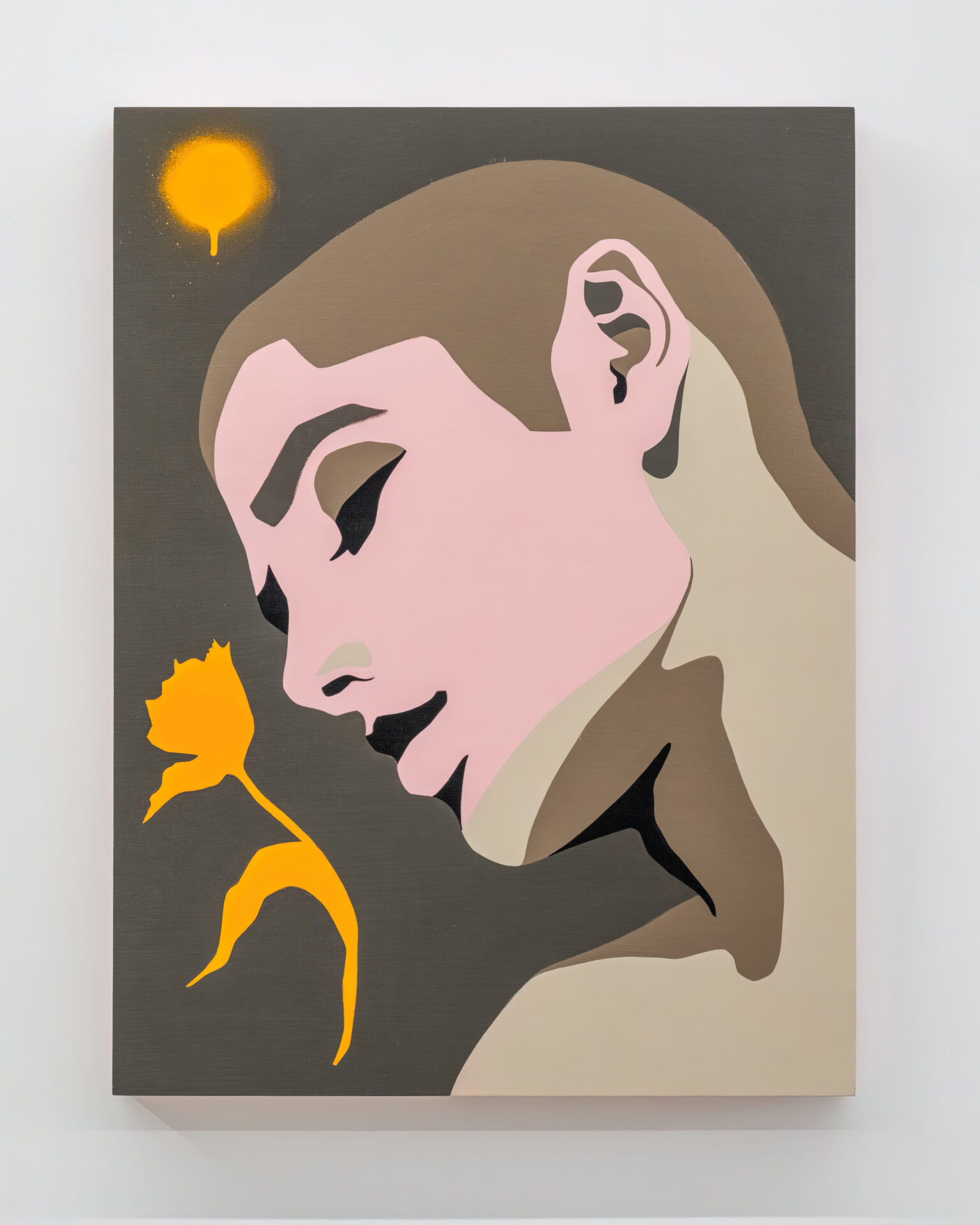
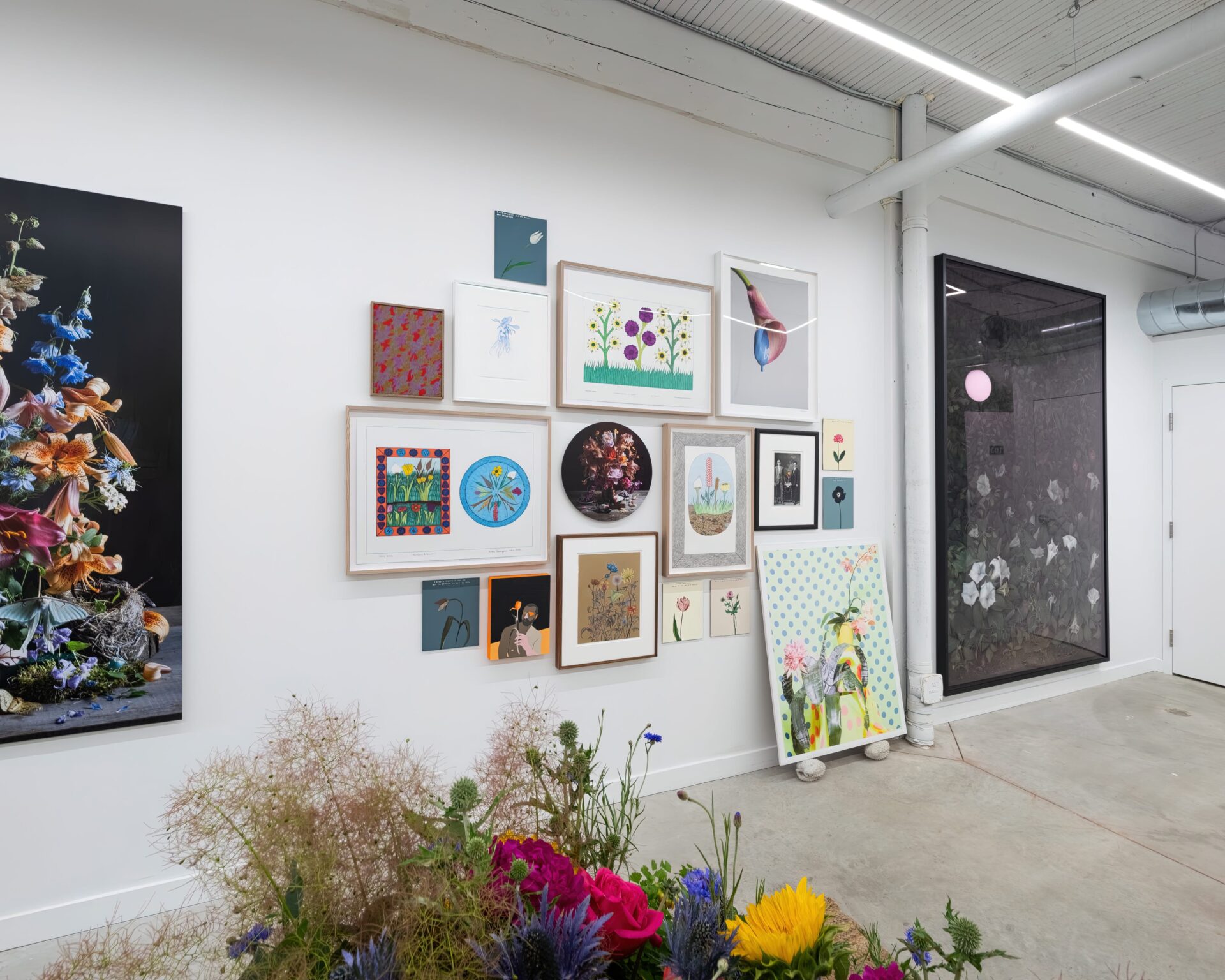
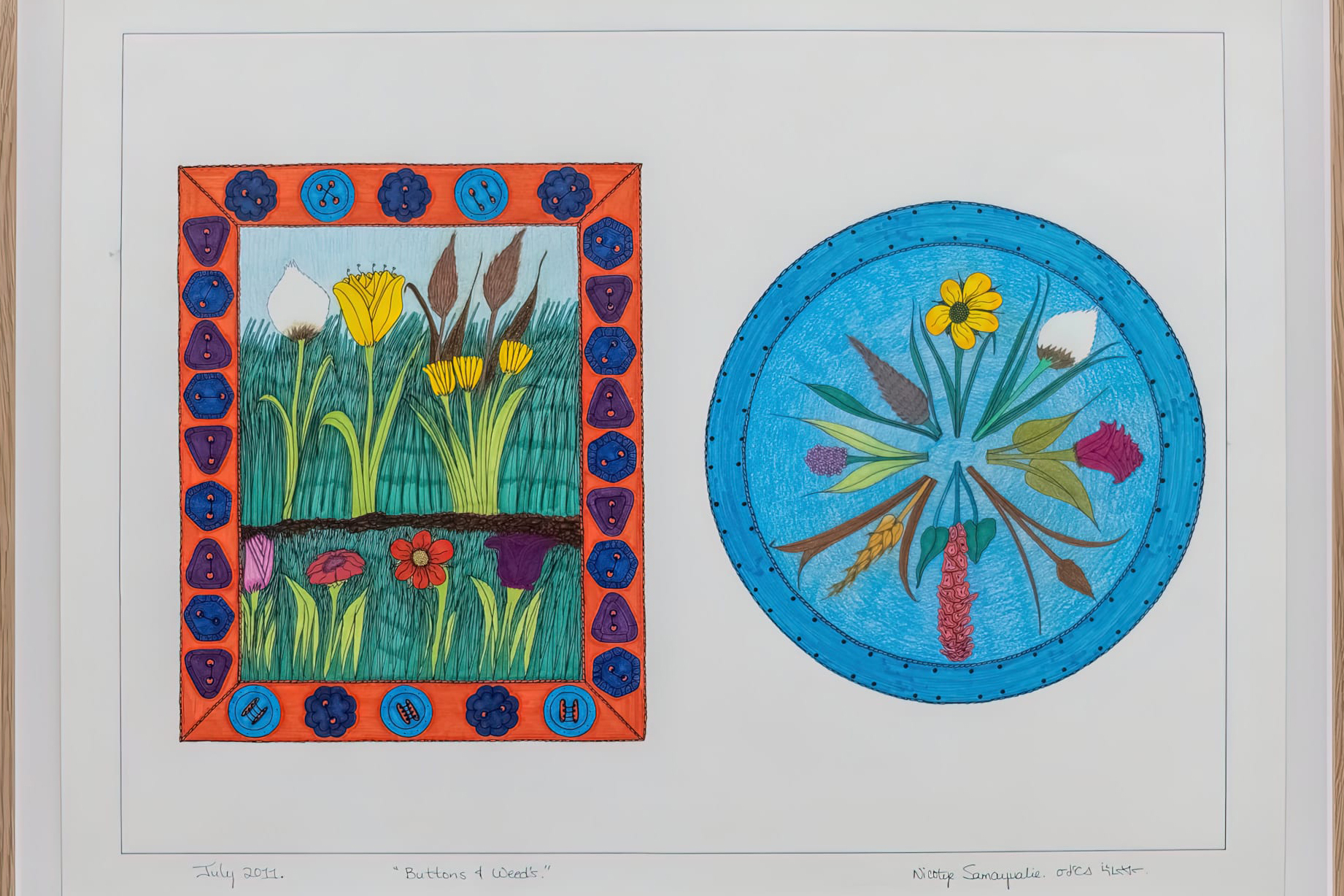
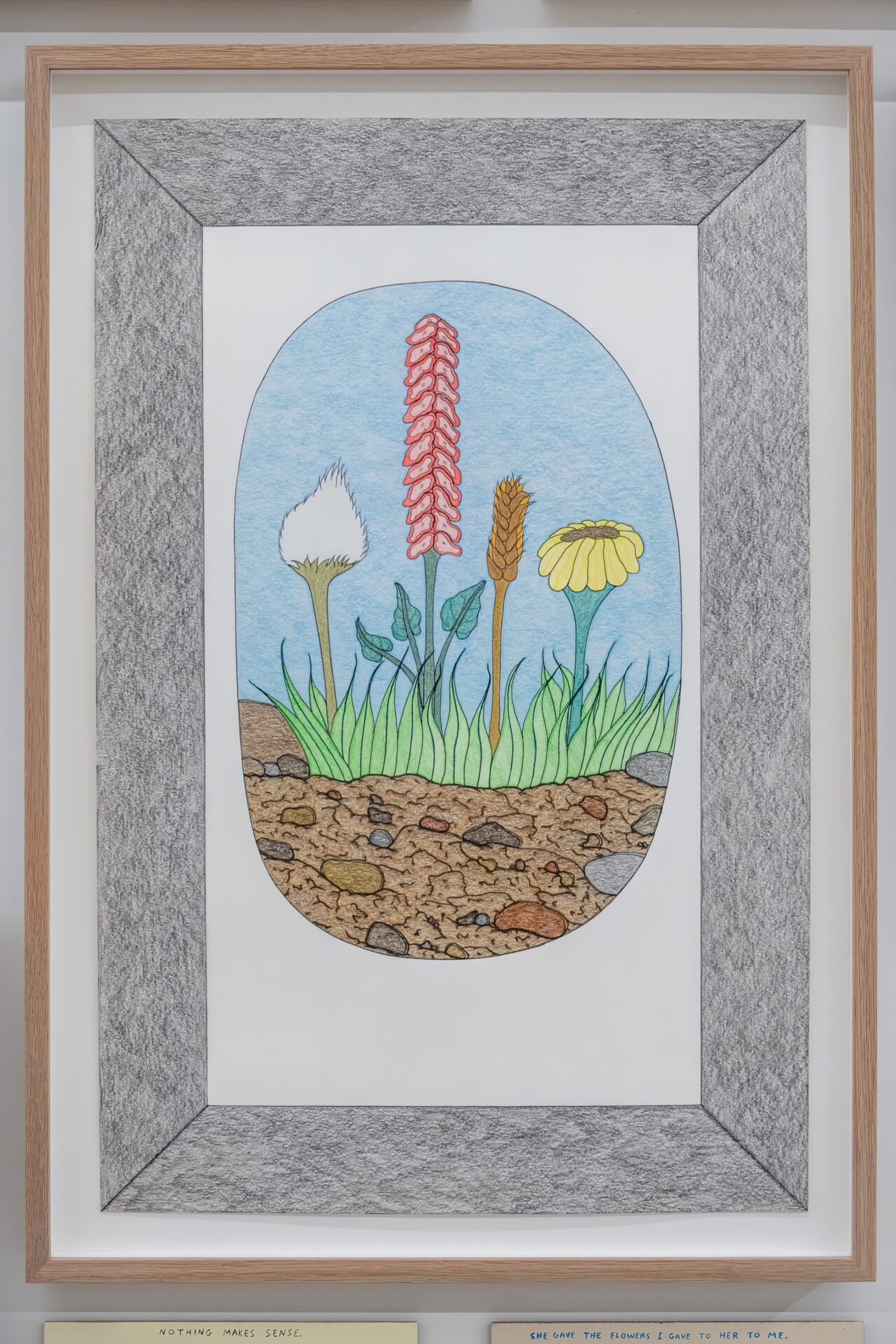
Nicotye Samayualie — Biography
dorsetfinearts.com/nicotye-samayualie
“Buttons attract me because they are made of different colours and shapes. I like colourful buttons.”
Nicotye Samayualie is the daughter of Kudluajuk Ashoona and Johnny Tunnillie Samayualie. Nicotye’s grandmother, Keeleemeeoomee Samayualie was a well known graphic artist whose prints were represented in the Kinngait (formerly Cape Dorset) annual print collections throughout the 1970’s and 80’s.
Nicotye is fascinated by patterns and arrangements of disparate objects in nature and man-made materials. Many of her drawings depict everyday items such as the contents of a pantry shelf, a table of shiny fishing lures or boxes of camping supplies.
Nicotye has had her original drawings shown at the Toronto Art Fair and in 2013 her work was featured in an Italian publication, ‘Annie e le Altre’, an ambitious scholastic study that explored the role of women artists in Kinngait.
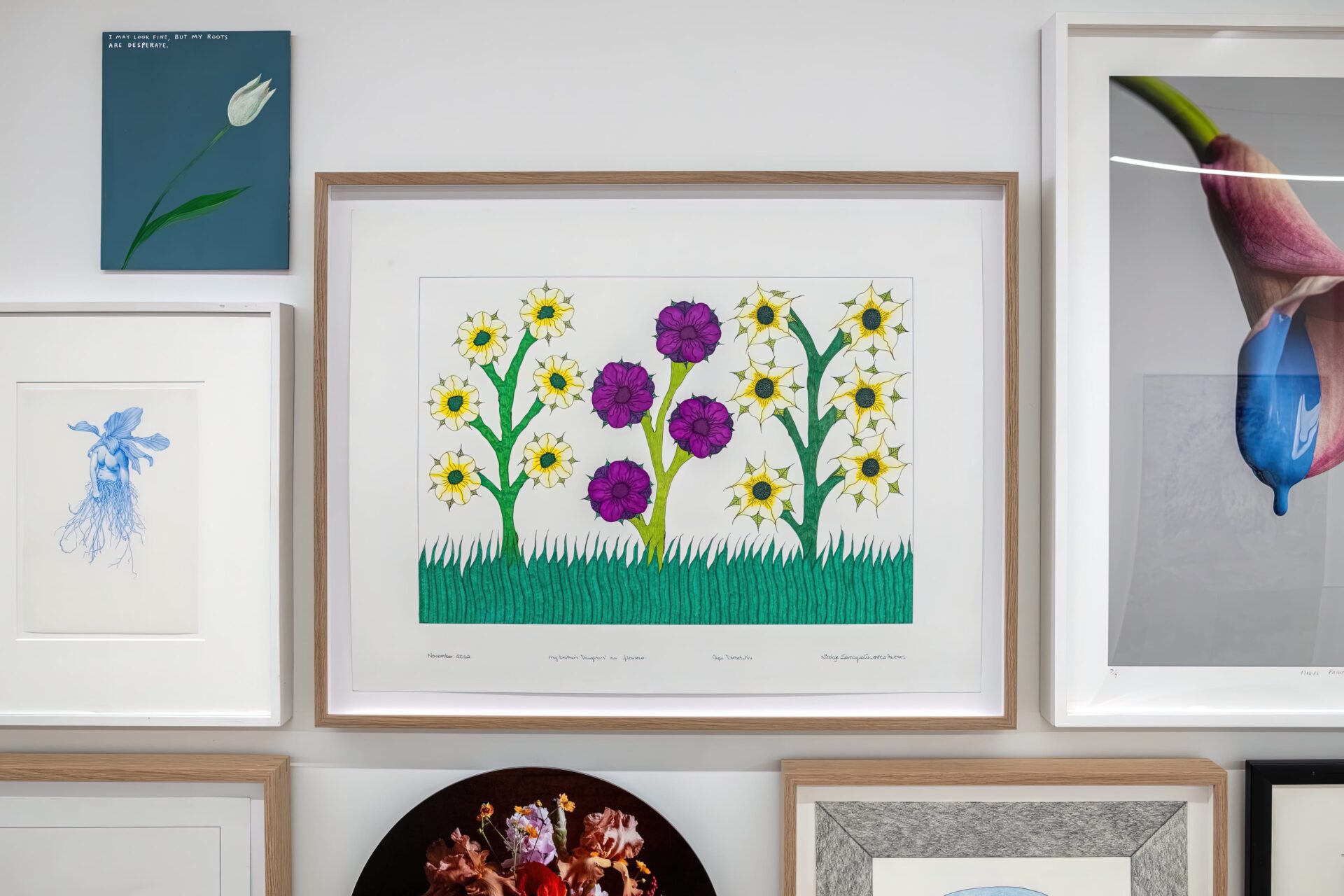
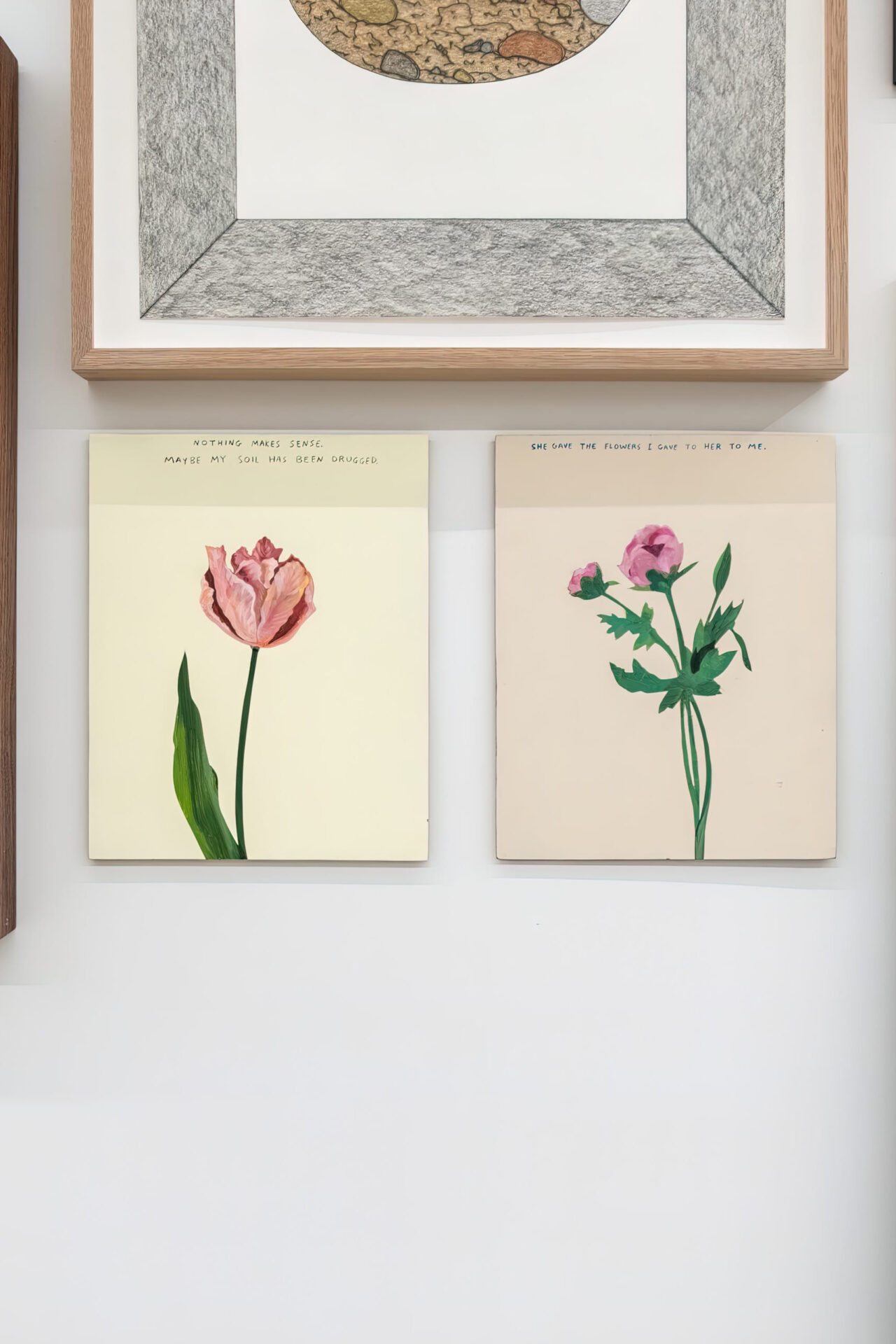
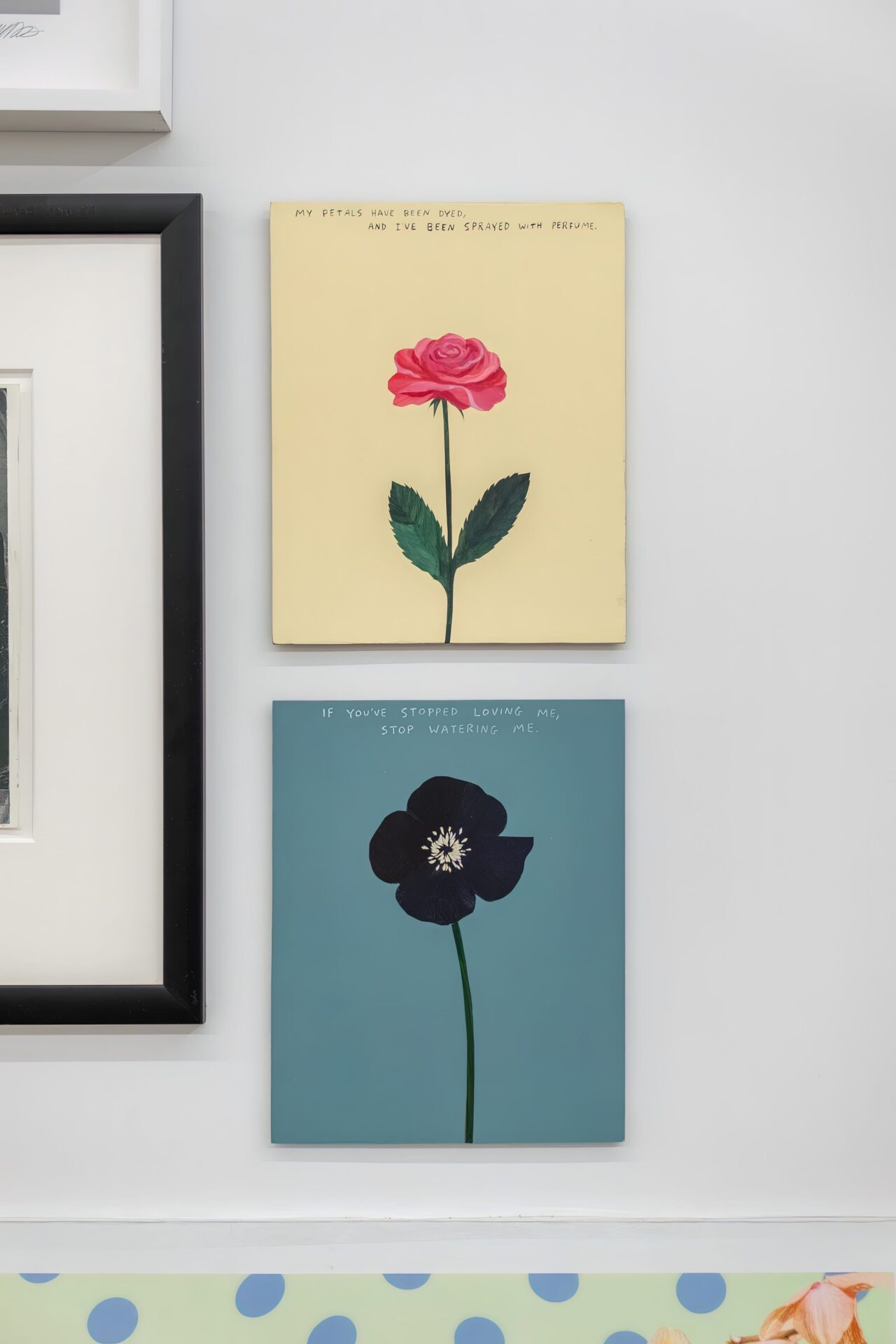
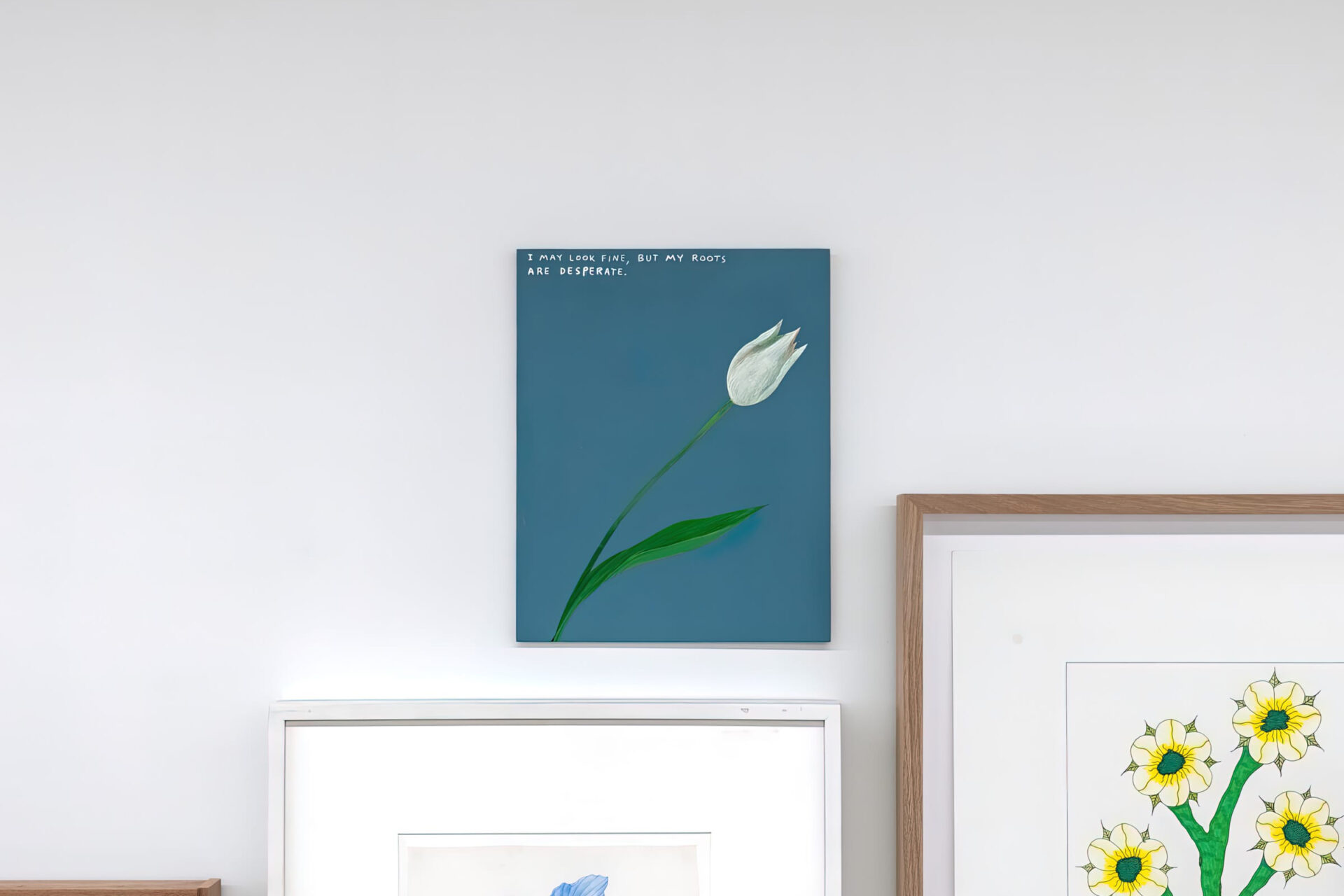

Michael Dumontier + Neil Farber — Biography
patelbrown.com/michael-dumontier-neil-farber
Michael Dumontier and Neil Farber are founding members of The Royal Art Lodge, and have continued a collaborative practice since the collective disbanded in 2008. Their work has been exhibited nationally and internationally. They were shortlisted for the Sobey Art Award in 2014. Dumontier and Farber’s work is included in the permanent collections of the National Gallery of Canada, Vancouver Art Gallery and Winnipeg Art Gallery as well as Takashi Murakami, Tokyo, Japan; La Maison Rouge, Paris, France; Centro De Arte Caja de Burgos, Burgos, Spain.
Dainesha Nugent-Palache — Biography
dainesha.com
Dainesha Nugent-Palache (b. Toronto, ON.) holds a BFA from Ontario College of Art and Design University (2016) where she was the recipient of The Dorothy Hoover Research Award, and an OCAD University Photography Faculty and Friends Award. Her work has been exhibited Nationally through venues such as Patel Brown, the National Gallery of Canada, The Portrait Gallery of Canada, Prefix Institute of Contemporary Art, Gallery TPW, the Art Gallery of Ontario, and TRUCK Contemporary, and internationally in New York, Finland, and Vienna. Her work can be found in The Wedge Collection, Toronto Dominion Bank Art Collection, EQ Bank Art collection, as well as several private collections. Nugent-Palache was a 2021 recipient of the Scotia Bank New Generation Photography Award. She currently lives and works in Toronto, ON. and is a founding member of Toronto artist collective and gallery the plumb.
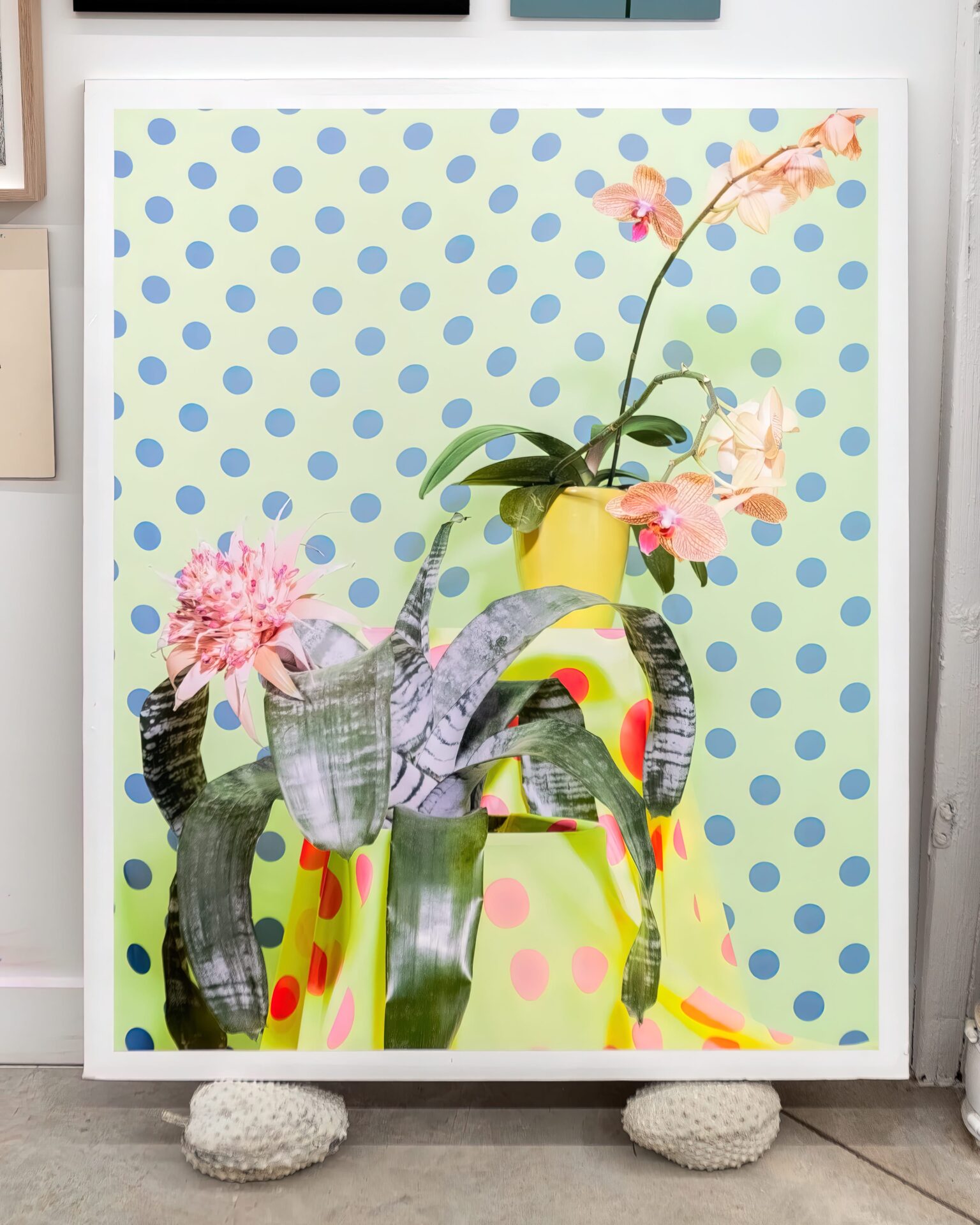
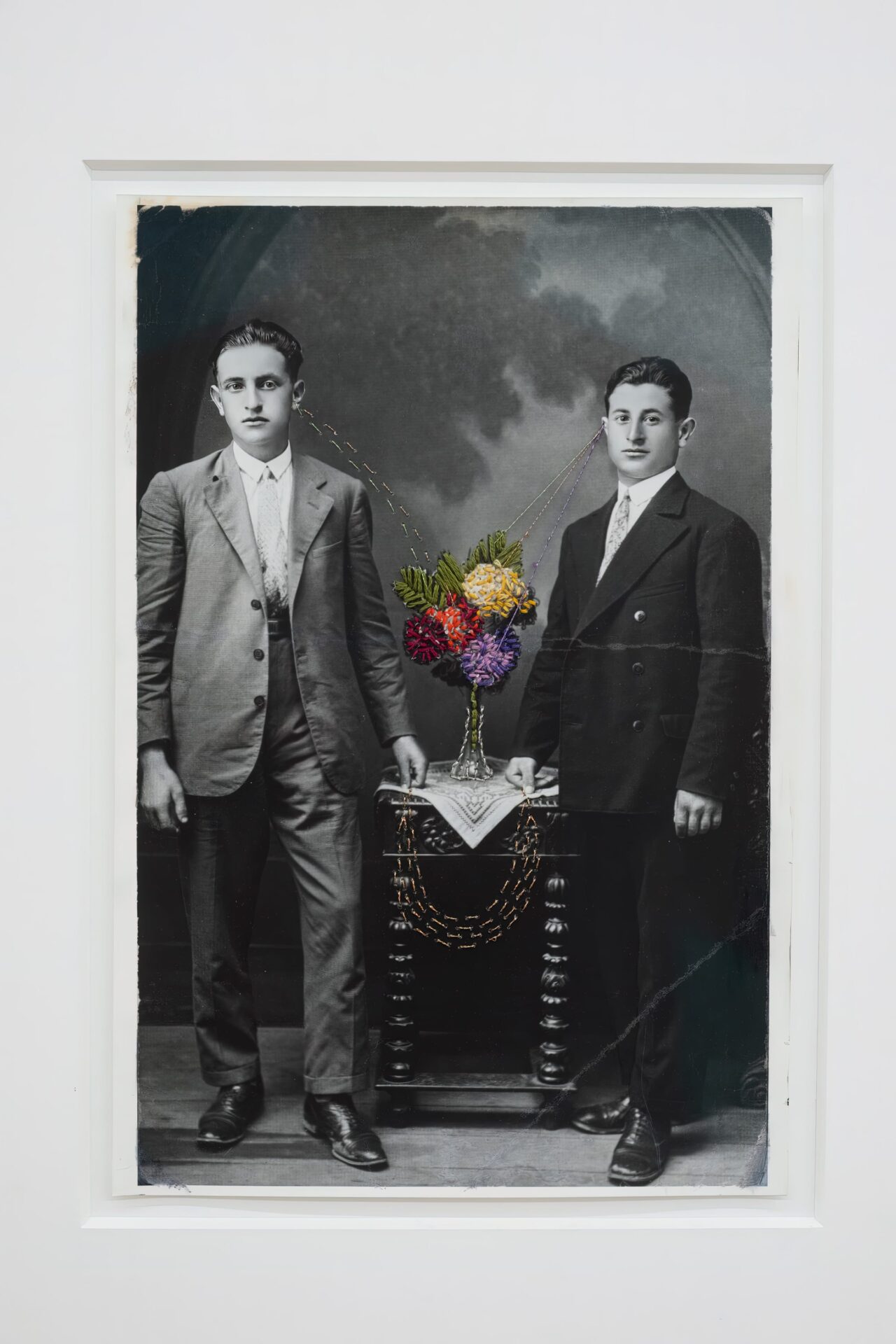
Janet Morton — Biography
paulpetro.com/~Janet-Morton
Janet Morton has been exhibiting across Canada and internationally since 1992. She has received numerous awards and accolades for her work, which playfully and critically examines our relationship to the natural world and everyday objects. Morton uses knitting and sewing symbolically in her work as blatant low-tech metaphors. With equal measures of empathy and absurdity, Morton combines these stereotypically domestic techniques with reclaimed materials, and explores issues of consumption, value and time. Morton was born in Toronto in 1963. She received an honours B.F.A. York University. Morton currently lives in Guelph, Ontario. The artist began incorporating wool and yarn into her laborious textile-based work in 1992. Morton states; ” Since 1992 I have used knitting and sewing symbolically and subversively in my work, as blatant low-tech metaphors. By employing these stereotypically domestic techniques and materials, I shift the axis from private to public, mundane to monumental, and attempt to address the confounding and complex ways that “value” is assigned to both objects and time investment.” She also uses recycled materials and materials from nature, and additionally works in video, performance, and public sculpture. Occasionally, Morton works collaboratively.
Nelson Hendricks — Biography
nelsonhenricks.com/
Nelson Henricks has taught art history and video production at Concordia University, McGill University, UQAM and Université de Montréal. An artist, writer, curator and musician, Henricks is best known for his videotapes and video installations, which have been exhibited worldwide. A focus on his work was presented at the Museum of Modern Art in New York, as part of the Video Viewpoints series in 2000. His writings have been published in exhibition catalogues, magazines, and in several anthologies. Henricks was the recipient of the Bell Canada Award in Video Art in 2002 and received the Board of Governors’ Alumni Award of Excellence from the Alberta College of Art and Design in 2005.
About the Artwork “Flower Painting”
Two flowers are associated with the Aesthetic Movement: the sunflower and the lily. They appear regularly in paintings by Aesthetic artists, or are featured as design elements in wallpaper and fabrics. For the video installation A Lecture on Art, Henricks drizzled paint onto these two flowers. The artist was immediate struck by the potency of these images. They are violent, yet also seductive and captivating and hint at how notions of aesthetics have transformed since the birth of modernism: beauty is no longer beautiful. This is the central paradox that animates the Flower Painting photo series.

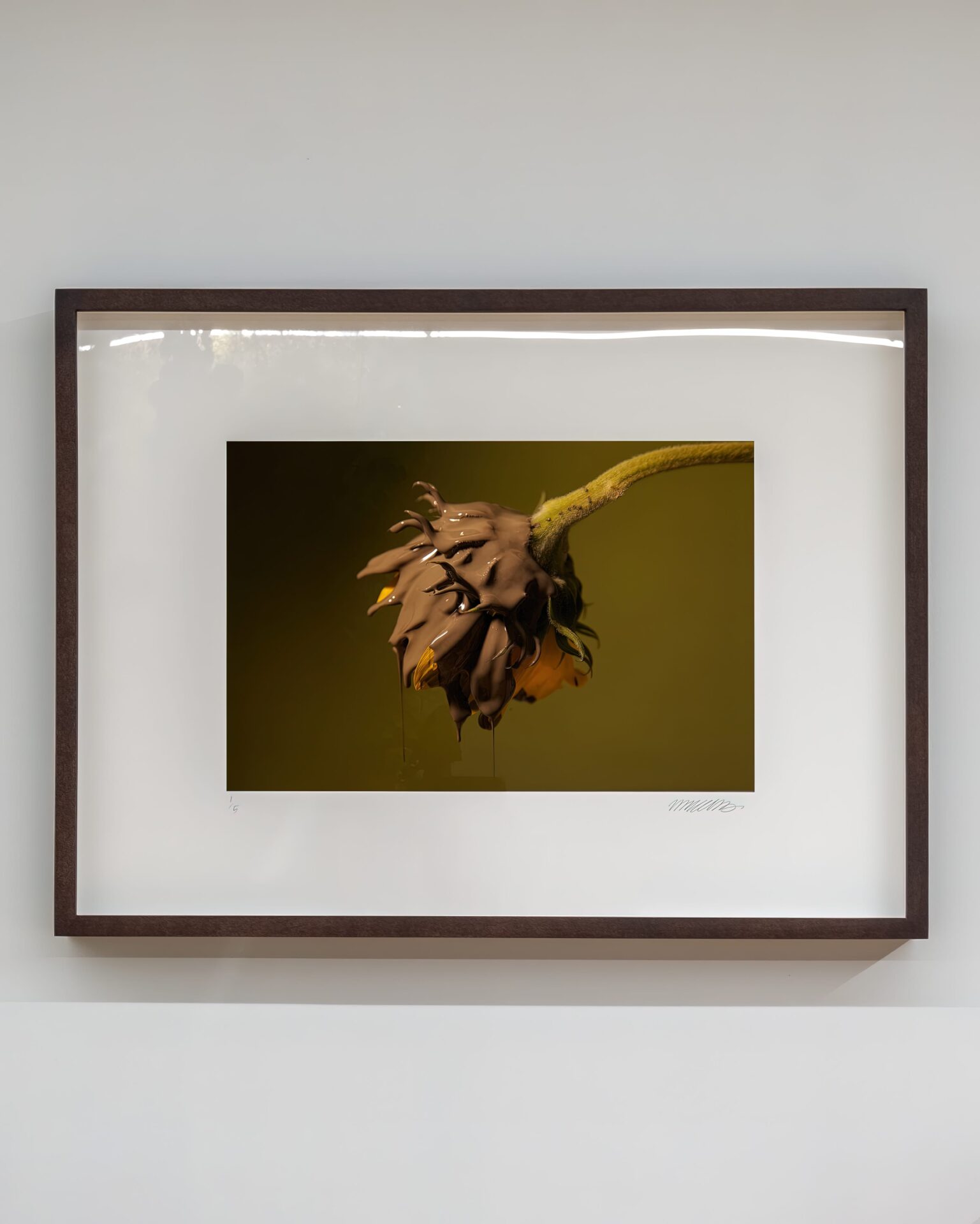
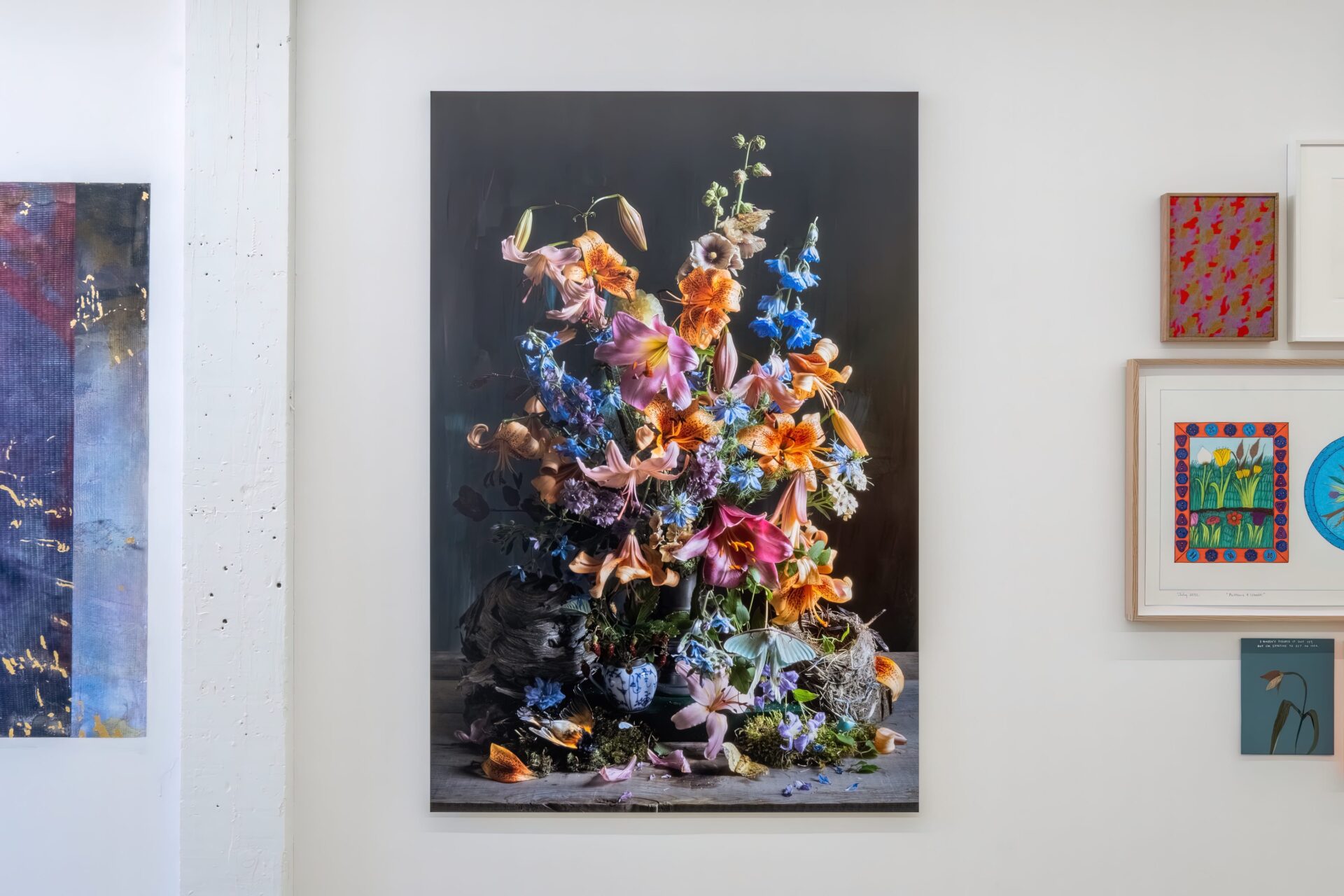
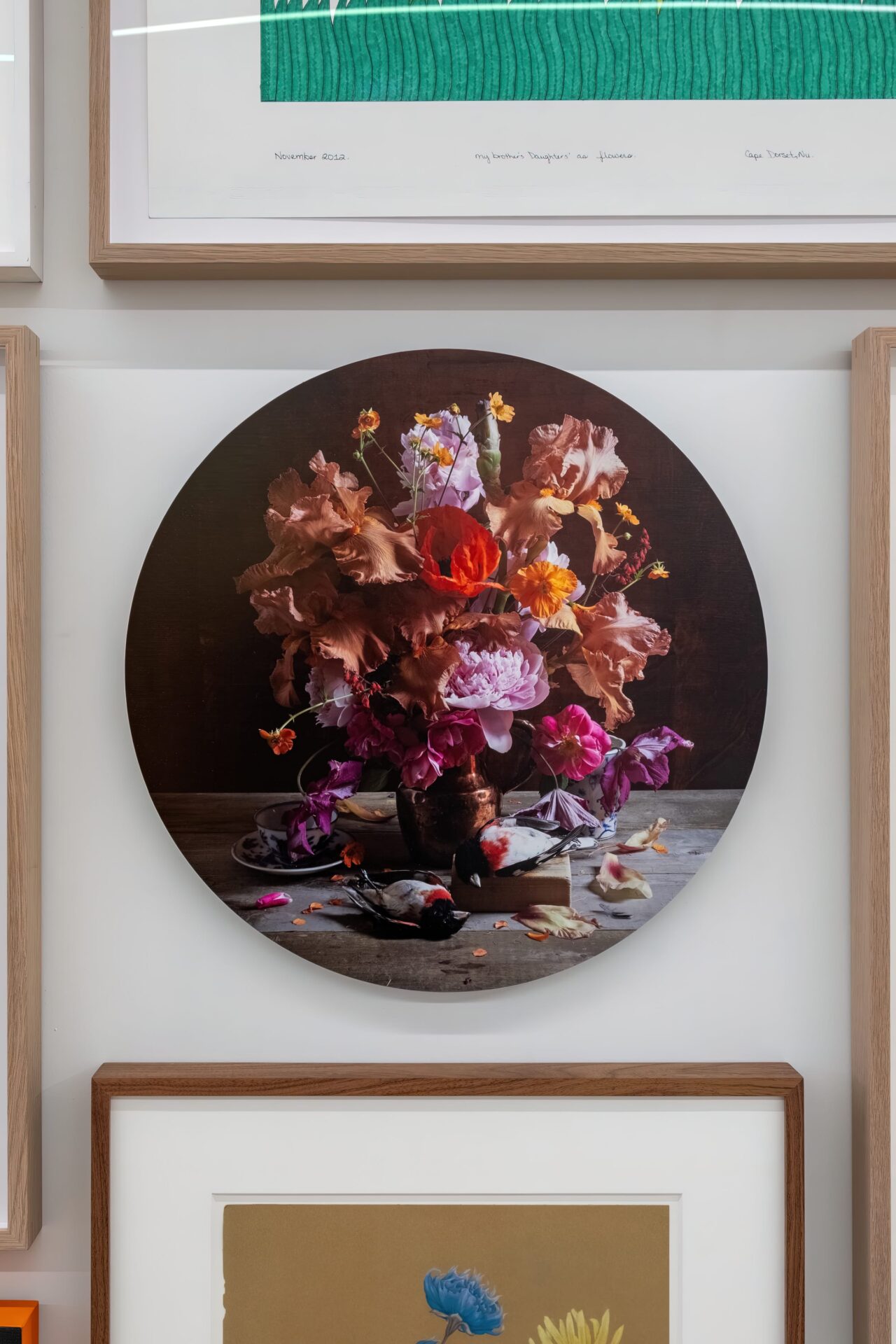
Kristin Sjaarda — Biography
kristinsjaarda.com
Kristin Sjaarda is an artist based in Toronto, Ontario, where she lives with her husband and three sons. Known for her large scale, lush still-life photos of garden flowers and fauna found in her local, urban environment; her work has been exhibited internationally. Kristin also has designed silk scarves based on the photographs. She has taught workshops on her style of natural light still life photography.
About the Work “Polinator”
This past season, inspired by the paintings of Rachel Ruysch (1664, The Hague), Kristin began including local moss and mushrooms to evoke the forest floor in the tradition of “sottobosco” (understory) paintings. In contrast to flowers at the height of bloom in the arrangements, the lower section of the photographs feature pests, bug-eaten leaves, fungus and decomposition. This push-and-pull between opposites- light and dark, blooming and composting, predator and prey, forms the framework for this series.
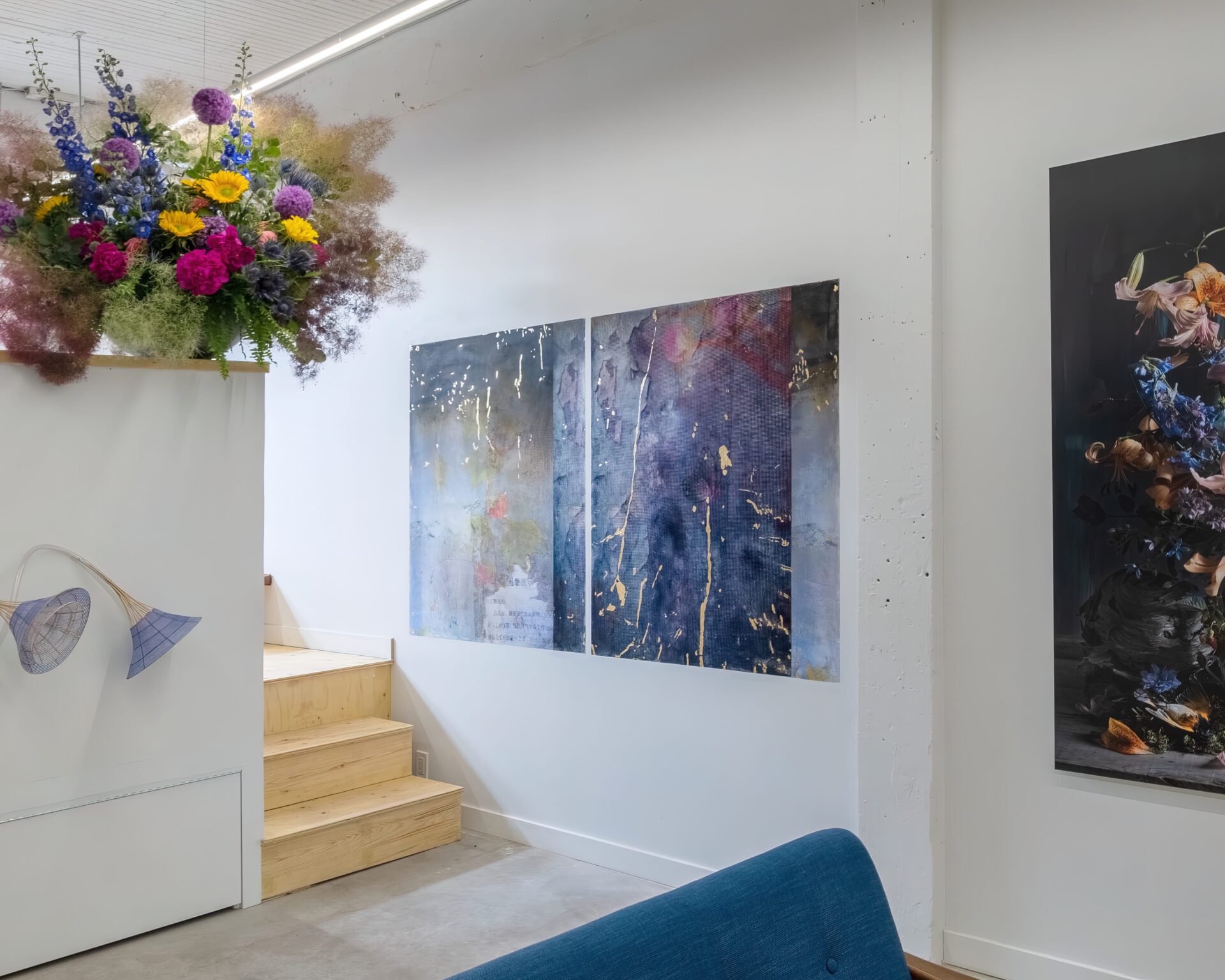
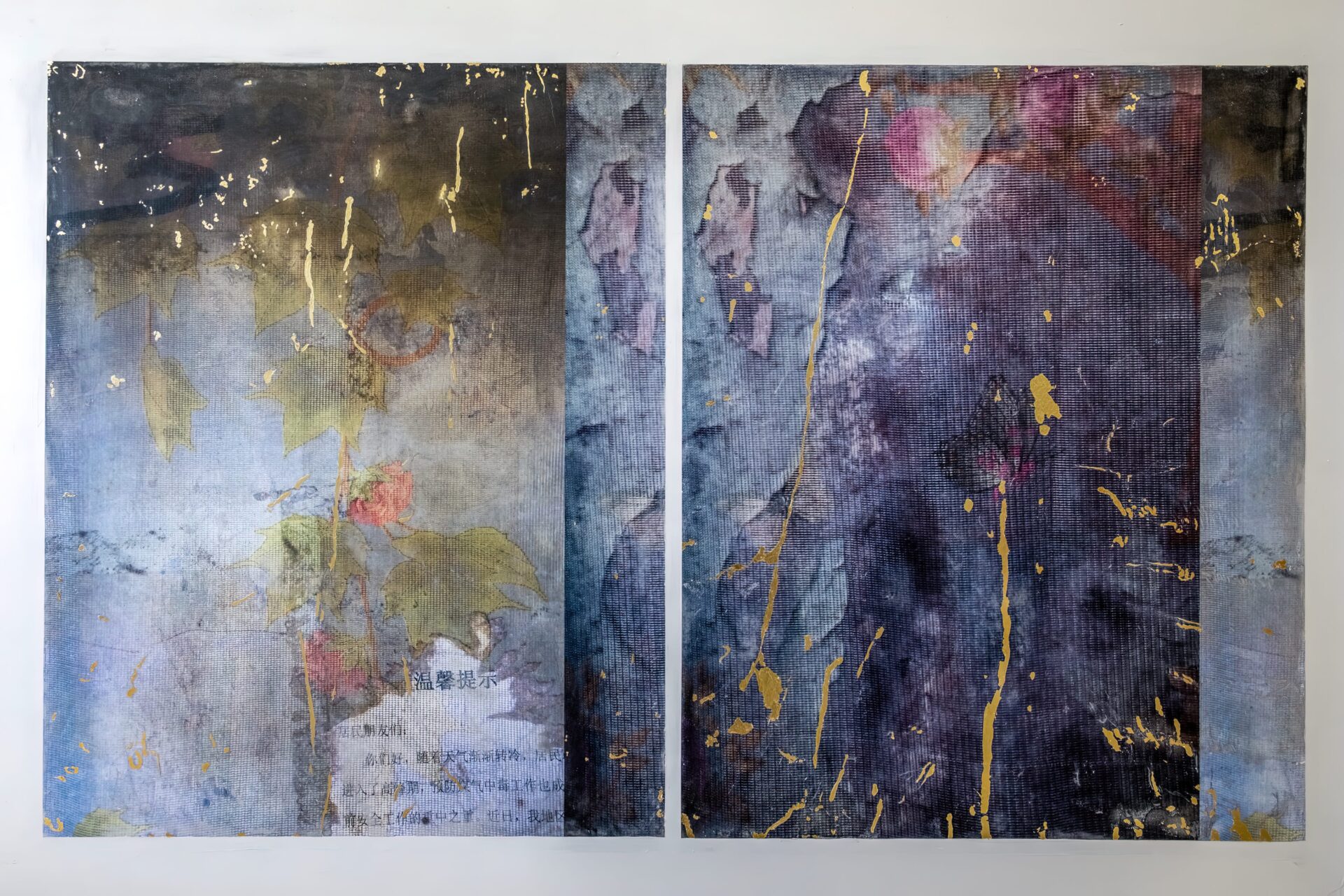
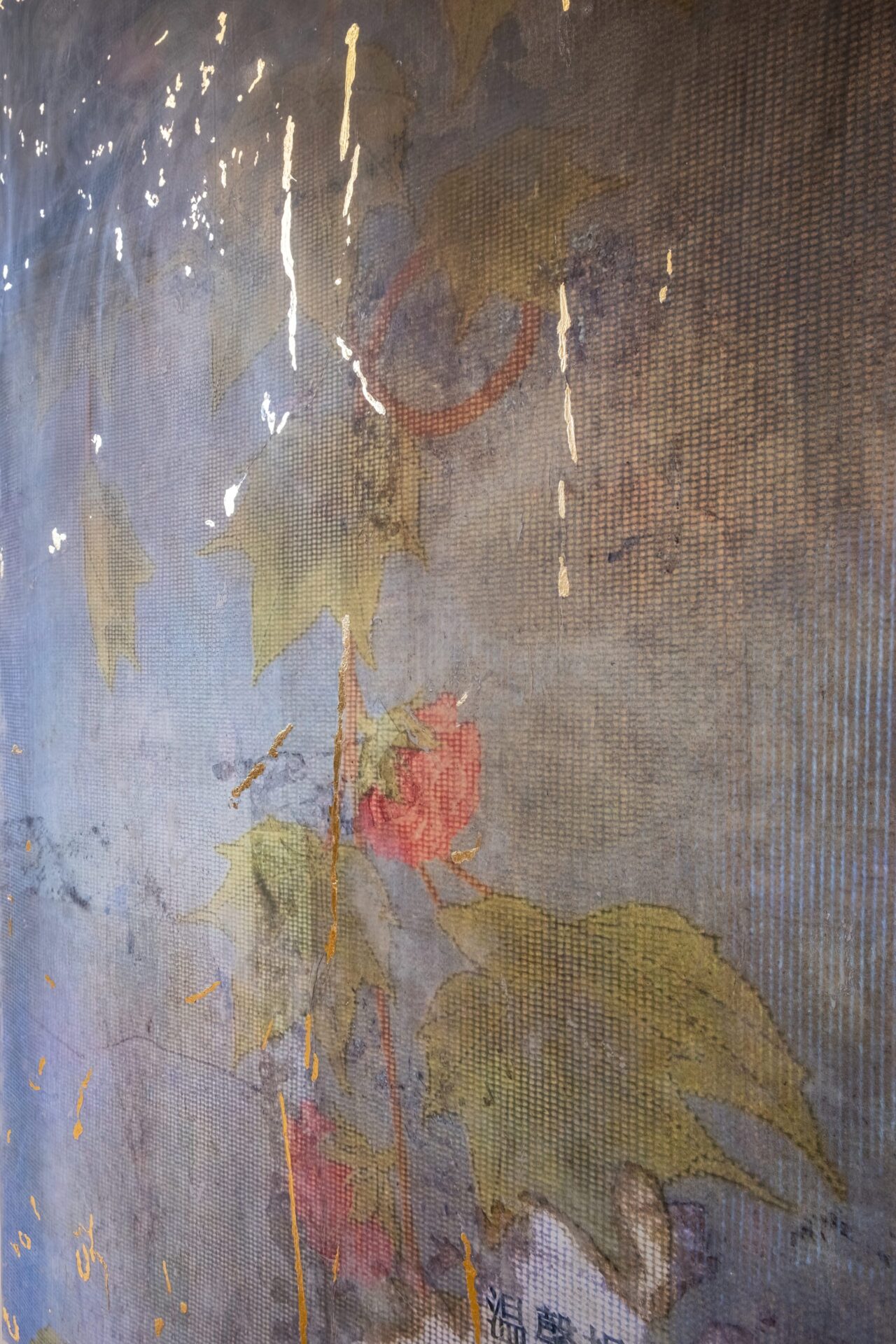
John Monteith — Biography
john-monteith.squarespace.com
John Monteith graduated with a Masters in Fine Art from Parsons, the New School for Design (2008) and his BFA from The Ontario College of Art and Design University (1997).
While prioritizing a practice that considers conceptual, material and aesthetic concerns equally, Monteith consistently works across mediums, pushing and expanding rigid disciplinary boundaries whether through photography, painting, drawing, textile-making,or curation and collaborative initiatives. Informed by cities that bear a diverse history of the built form in their articulation of spatial dynamics and representational politics Monteith’s practice draws on issues of identity, memory and history.
He has exhibited internationally at the Tate Modern, London, the Schinkel Pavilon, Berlin, X Initiative, New York, the Taipei Contemporary Art Center, Taipei, the DUMBO Art Center, New York, 7th Beijing Biennale, Beijing, and Sàn Art, Ho Chi Minh City.
Monteith has held residencies at CAT Cologne, Germany (2011), Kunsthalle Roveredo,Switzerland (2014), I Project Space, Beijing (2018). Reviews and essays dedicated to his work have been included in Mousse Magazine, Canadian Art, Art in America (print and online), Charley, C Magazine, October, The Huffington Post, K-48, Petit Mort: Recollections of a Queer Public, the New Yorker and others. Monteith has been awarded grants from The Canada Council for the Arts, The Ontario Arts Council, and The Toronto Arts Council. He currently lives and works in Toronto, Canada where he is a Sessional Lecturer at the University of Toronto, John H. Daniels Faculty of Architecture, Landscape and Design. His work can be found in the following collections, The Canadian Embassy, Ankara,Turkey, Majudia, Montreal, Canada, Bank of Montreal, Canada, The New School, Manhattan, New York, Torys LLP, Toronto, Canada, TD Bank, Canada, BNY Melon, New York, USA, Morris and Associates, London, England.
About the Artwork, Untitled (An Excerpt, beijing)
“Literary techniques of reading historically, intertextually, constructively, and deconstructively at the same time can be woven into our understanding of urban spaces as lived spaces that shape collective imaginaries. We have come to read cities and buildings as palimpsests of space … The strong marks of present space merge in the imaginary with traces of the past, erasure, and loss.” —Andreas Huyssen
As Beijing undergoes massive structural changes and swift redevelopment of its political, cultural and spatial dynamics, Monteith spent four years between 2014 and 2018 documenting the at risk and disappearing neighborhoods of Beijing, due to be demolished and redeveloped to make way for new shopping centers, condominiums and other infrastructure projects. While focusing on the quotidian, heavily textured surfaces and provisionally placed materials bear witness to these communities and the traces of time.
These close observations are photographed, layered and shifted. Monteith formally constructs each composition investigating the poetic dynamics of provisional space that occupies a liminal fluid position between memory and time. Images are dislocated from their surroundings, concealing as much as they reveal, asking for a response that measures reflection and meaning.
As photographic compositions, this body of work not only documents corners of the city which go often unnoticed but interprets this urban space as contingent and temporary. Functioning intertextually, while referencing issues of temporality, ephemerality, disappearance, and indexicality Monteith gives space new form, perspective and weight.
Monteith would like to acknowledge the Canada Council for the Arts, with thanks to I: project space, Beijing for their support in the creation of this work.
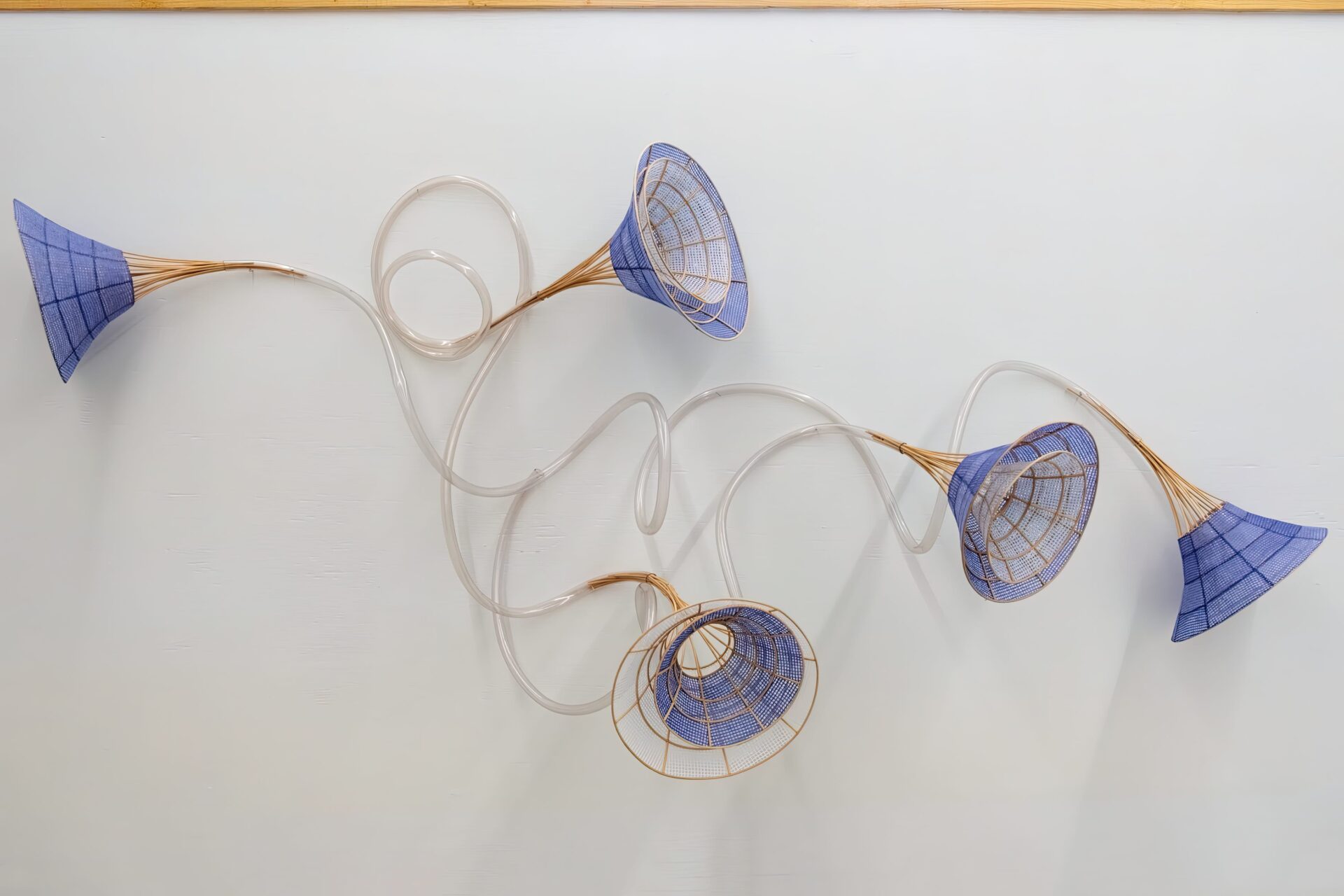
Xiaojing Yan — Biography
yanxiaojing.com
Xiaojing Yan is a Chinese-Canadian artist whose work embraces her sense of having a hybrid identity. Settling permanently in the Toronto area, her work reflects her journey through these various cultures, arriving at her own personal vocabulary. Her unique point of view unites the past and the present, encompassing culture and nature, art and science.
Most recently, she has had solo shows at Hermès Maison, Shanghai, China, Richmond Art Gallery, Richmond, BC, Canada, Chinese American Arts Council, NYC, and Suzhou Museum, Suzhou, China, Varley Art Gallery, Markham, ON, Canada. Yan has also completed public art projects in Canada and China including her Zodiac sign commission (2021) and installation “Cloudscape” (2018) at the Royal Ontario Museum, “Emergence” (2021) commissioned by Hermès, Shanghai, China.
Yan is a recipient of numerous awards and grants, including the 2014 Outstanding Young Alumni Award from the Indiana University of Pennsylvania, Project Grants from the Canadian Council for the Arts, the Chalmers Arts Fellowship, Mid-career Grants from the Ontario Arts Council, and a 2018 OAAG Exhibition Installation and Design Award and many more.
About the Artwork, Morning Glory
Morning glory blooms in the morning, withers in the evening, and completes its life cycle in one day. Inspired by traditional Chinese lantern and kite making techniques, I created this installation to reflect the growth cycle, metamorphosis, and cycle of life and death in nature. Although the works appear translucent, soft and light, within it embodies a complicated construction full of internal tension. In many of my works, I use suspension as an expression technique, constructing the concept of a “time pause”. Though morning glory has a brief life cycle in nature, even when constructed with fragile materials, it becomes eternal and static, as if someone pressed the pause button.
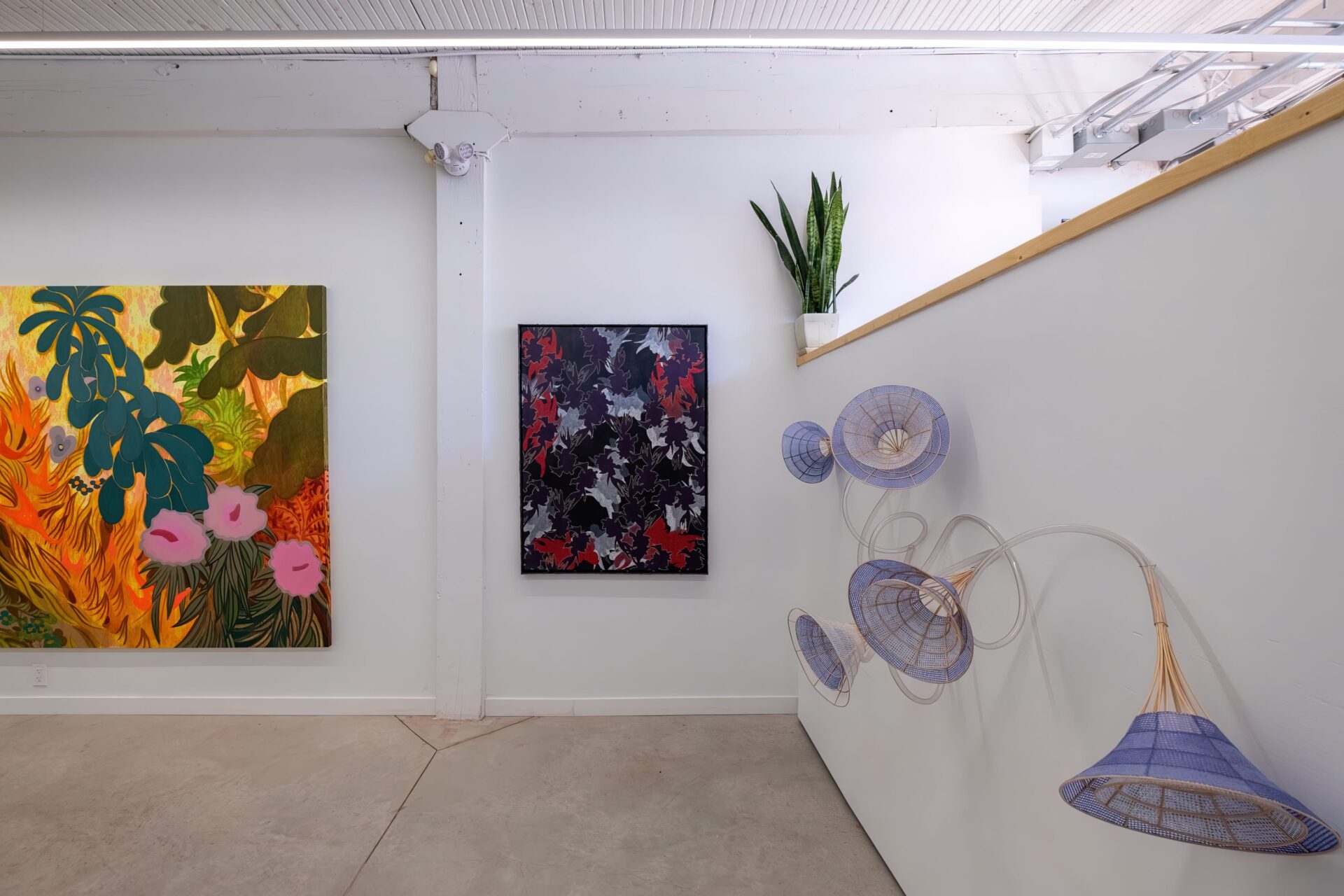
Emma Welch — Biography
emmawelch.info
(b. 1993 Ontario, Canada) is an artist living and working in Tkaronto/Toronto. Her practice circulates around a process of production she calls field psychedelia. She has recently presented her work at Erin Stump Projects (Toronto), Spacemaker ll (Toronto), and Egret Egress (Toronto). Her work is included in the collections of the Scotiabank Fine Art Collection, The Royal Bank of Canada and several private collections. She holds a BAH in Studio Art from the University of Guelph (2016). She is a co-founder and collective member of the plumb, an artist-run project space (Toronto).
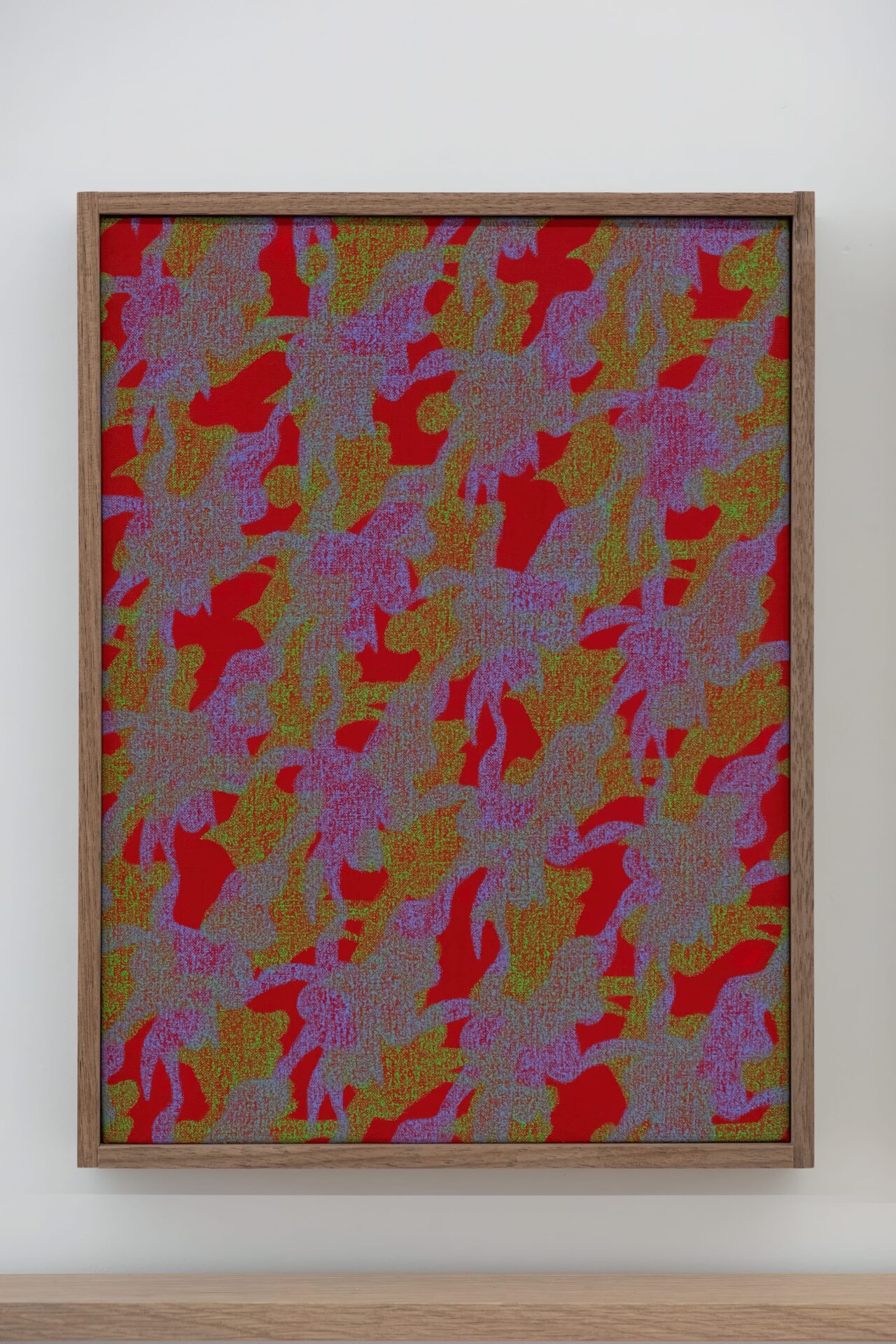
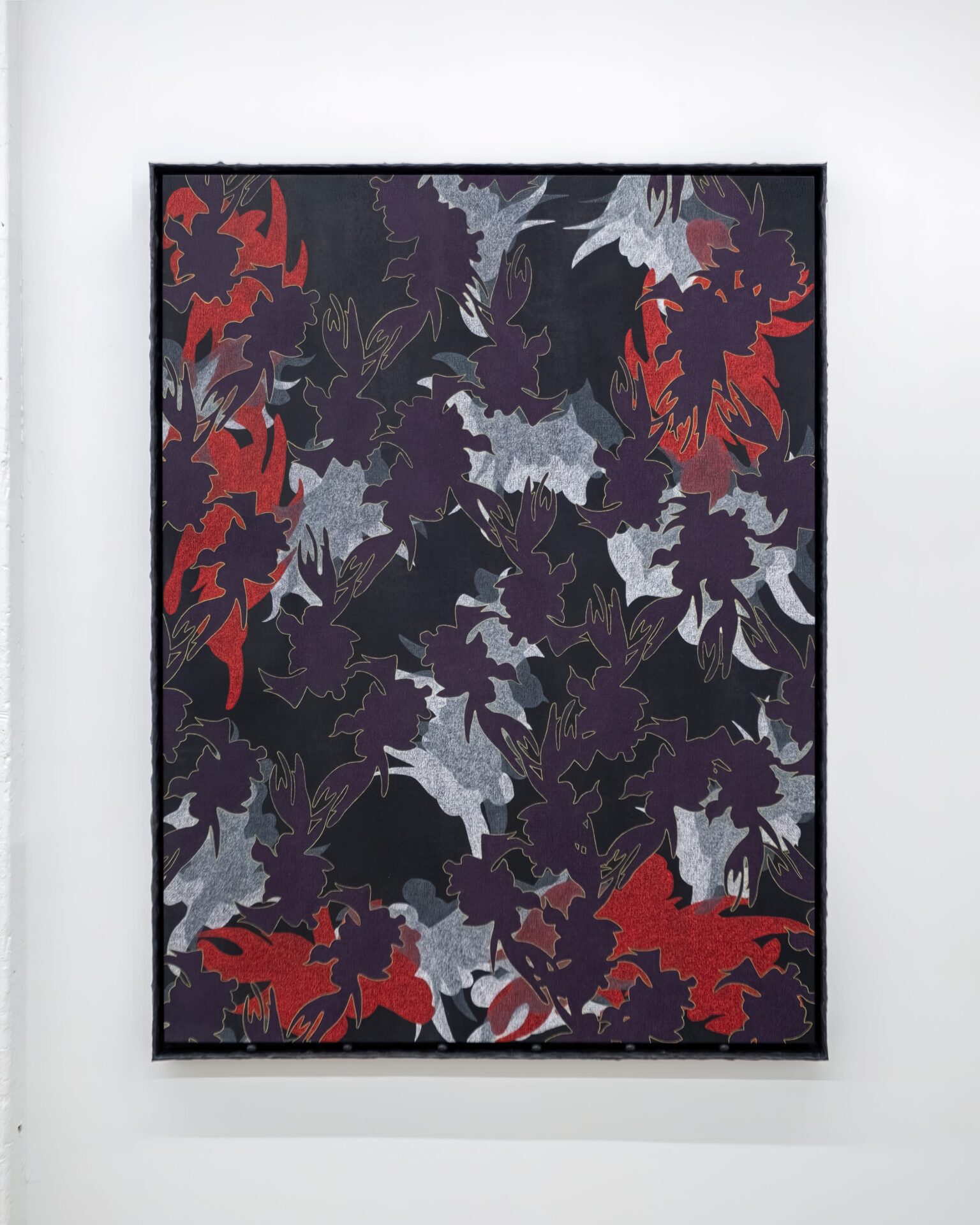
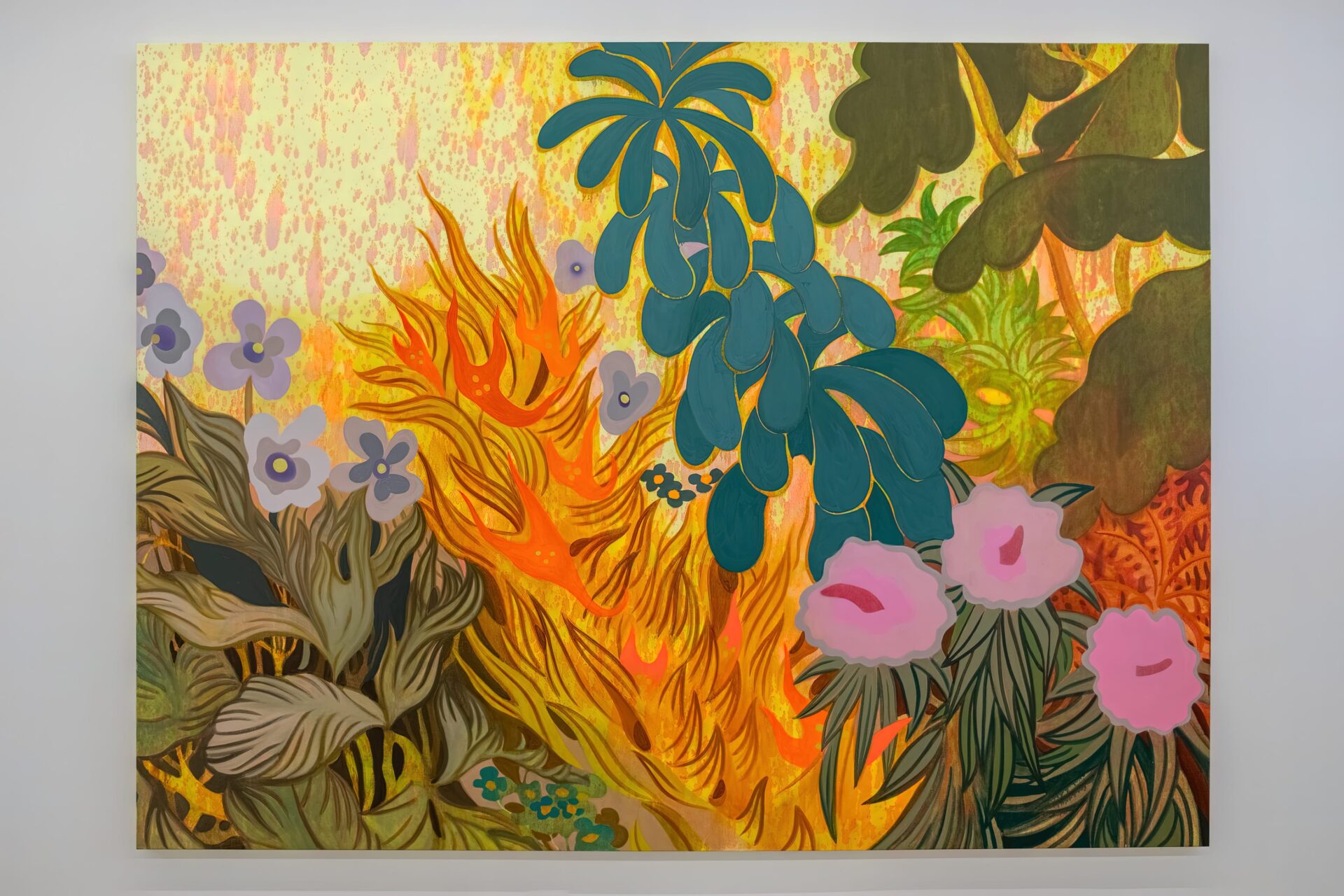
Rick Leong — Biography
rickleong.com
Rick Leong received his BFA from the University of Victoria (2003), and an MFA from Concordia University in Montreal (2007). Leong has participated in many group exhibitions at various Canadian and international spaces, including at the National Gallery of Canada (Ottawa), the Montreal Museum of Fine Arts (Montreal), the Contemporary Art Gallery (Vancouver), The Art Gallery of Greater Victoria (Victoria), and the Richmond Art Gallery (Richmond). Solo exhibitions include Swell at Empty Gallery (Victoria), The Fourth Pleasure at Parisian Laundry (Montreal) and The Phenomenology of Dusk at The Art Gallery of Greater Victoria (Victoria). He has been included in the exhibition RELATIONS : Diaspora and Painting at the Phi Foundation (Montreal). His works can be found in numerous collections, including the Montreal Museum of Fine Arts, the Caisse de dépôt et placement du Québec, the Canada Council Art Bank and the Art Gallery of Greater Victoria.
Leong’s landscapes, distinctly Canadian in their subject matter, are imbued with Chinese historical forms that defines the artist’s hybrid visual vocabulary. If this idiosyncratic style is a way for the artist to negotiate his shared heritage, it also serves to critically engage with the history of Canadian landscape painting, one dominated by white settler figures of the likes of Lawren Harris, Tom Thomson and Emily Carr.
For Leong, the formation of a personal identity and the feeling of belonging are intrinsically linked to one’s relationship with the landscape. British Columbia, wedged between the jagged, ice-capped peaks of the Canadian Rockies and the vast and turbulent Pacific Ocean is where Rick Leong grew up, and where he still calls home.
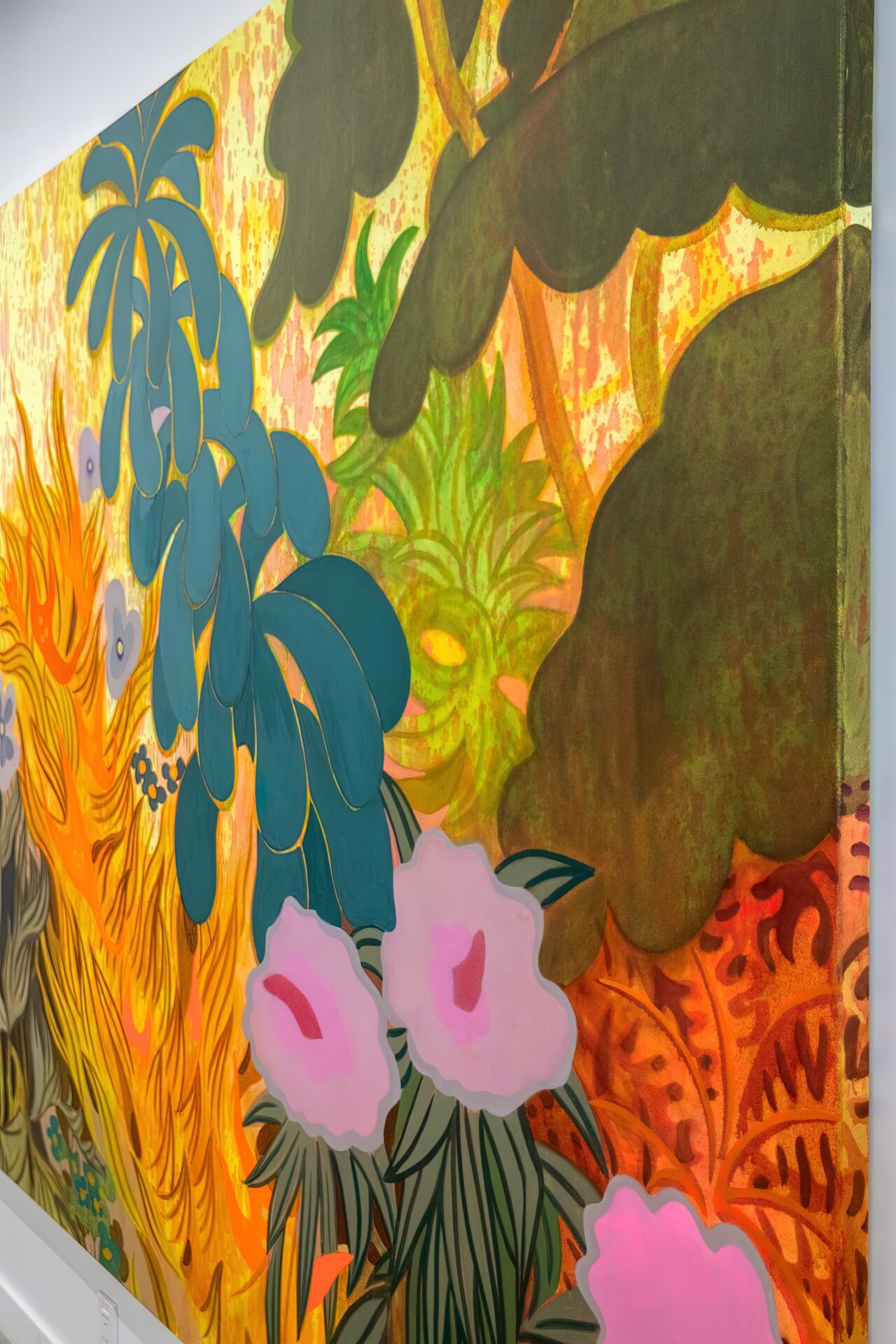
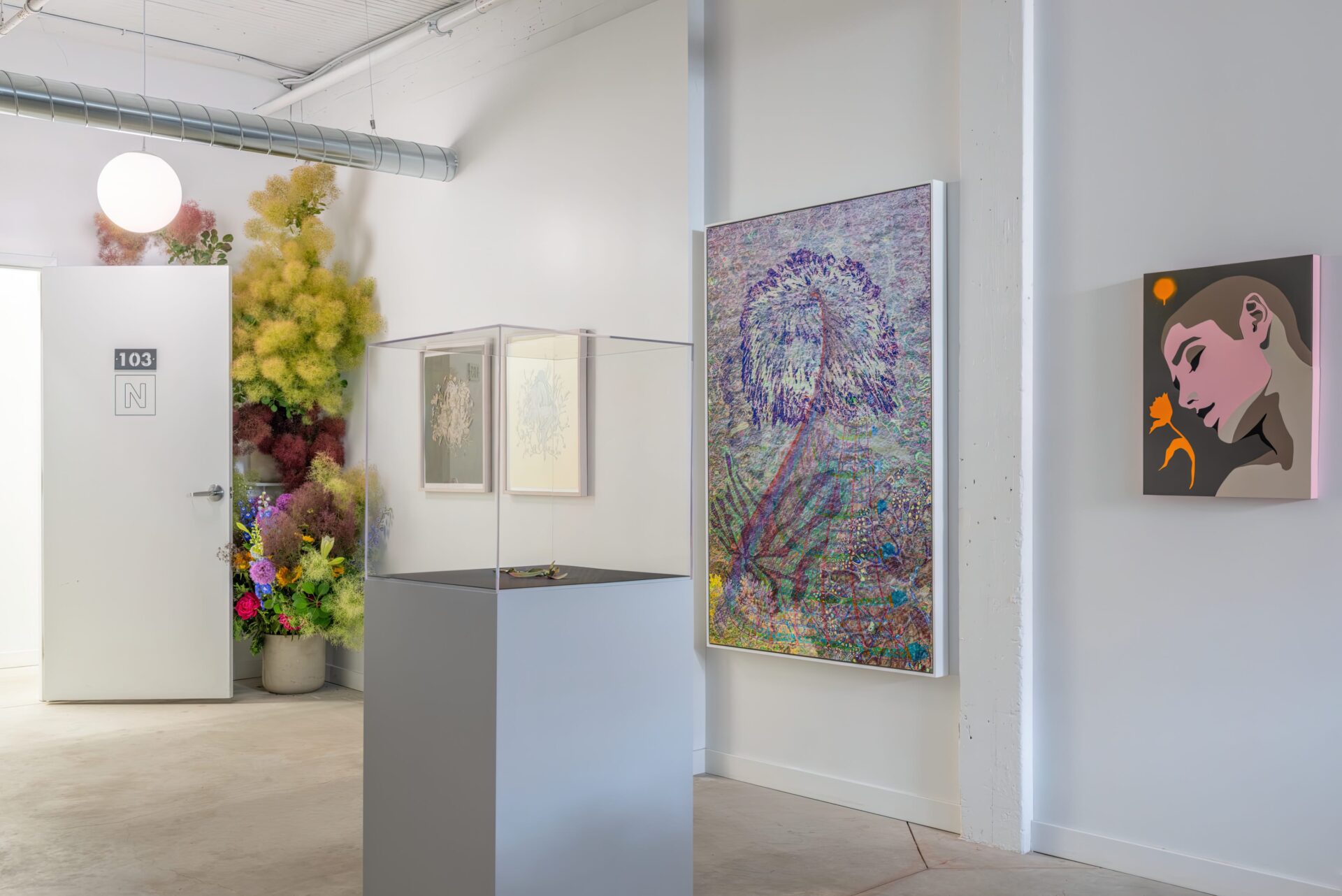
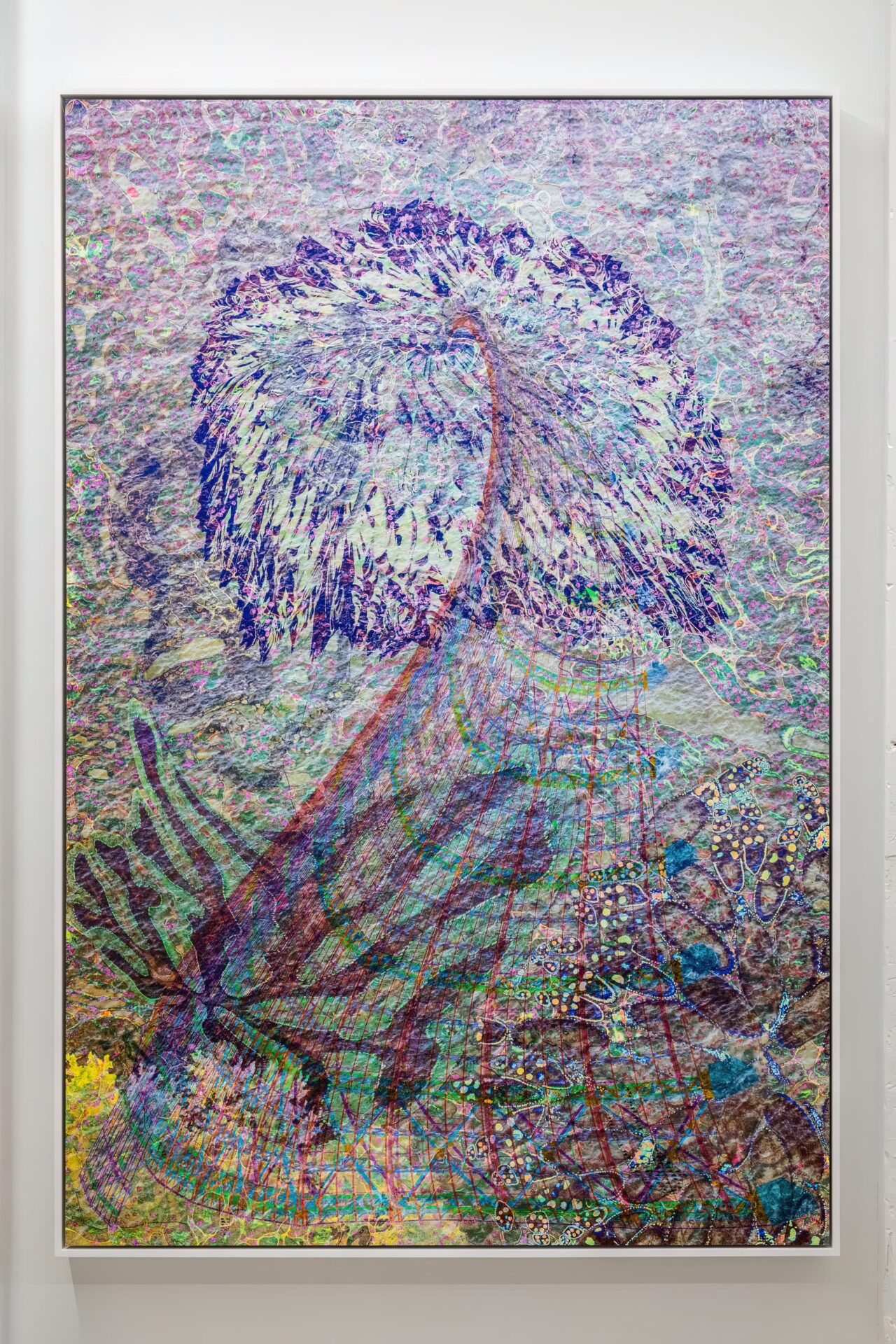
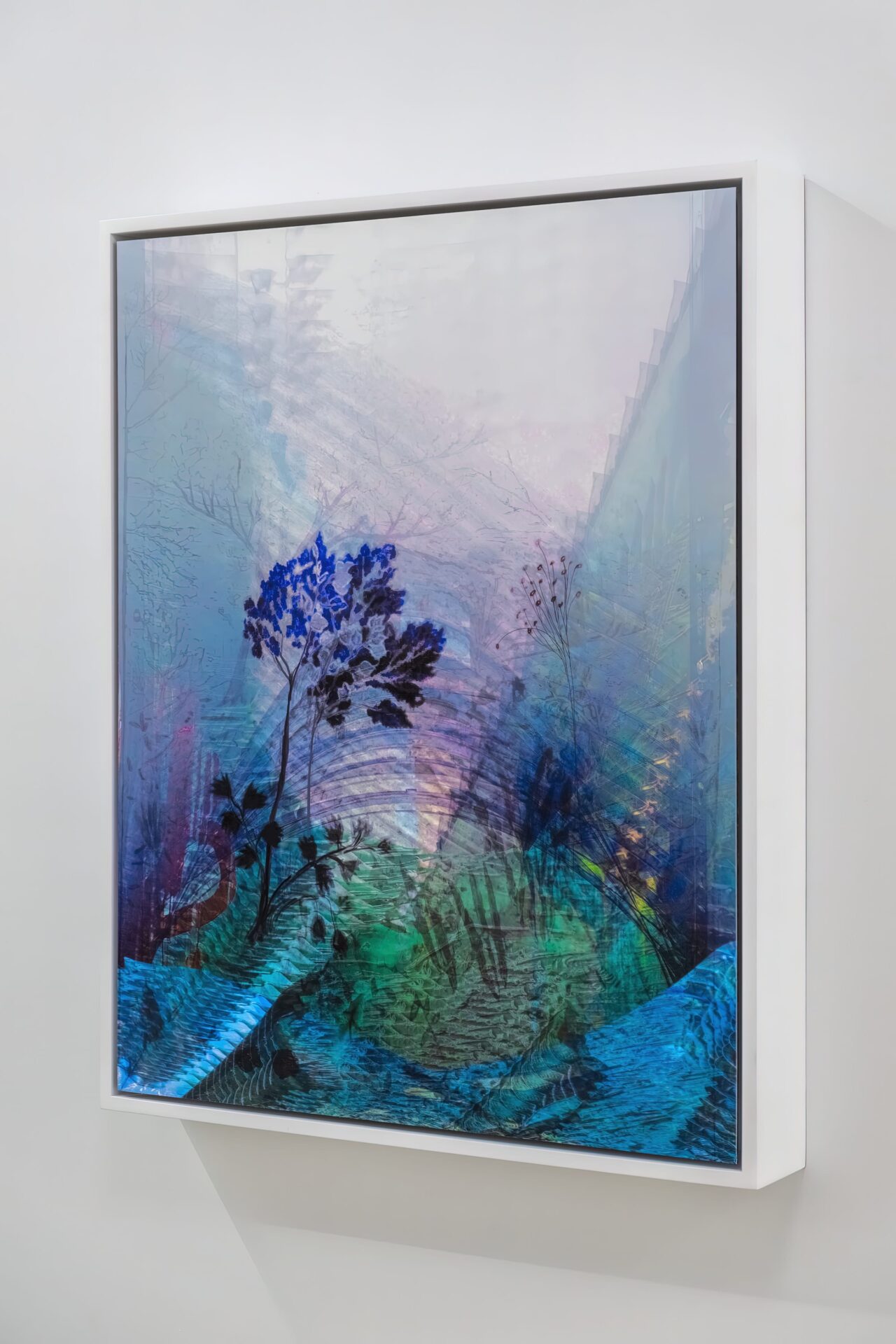
Alex Fischer — Biography
artofalexfischer.com
Alex Fischer is a visual artist and digital designer working across many different media and interfaces. Raised in rural Canada and based in Toronto, Fischer has developed bodies of work for public and private enterprises; placed major works in cities across the globe, succeeded as an architectural rendering designer, published in online and print, as well as a monograph (W9). They’ve also been invited as a juror, mentor, and speaker. Since receiving a Bachelor of Fine Arts Honours from York University in 2009, Fischer has continued academic, technical, and artistic studies, and has raised several solo exhibitions of work.
Winnie Truong — Biography
winnietruong.com
Winnie Truong is a Toronto based artist working with drawing and animation to explore ideas of identity, feminism, and fantasy and finding its connections and transgressions in the natural world. She has exhibited her work internationally and was a 2017 recipient of the Chalmers Arts Fellowship. Her work has been included on the CBC program The Exhibitionists, and in her recent survey exhibition at Saw Gallery in Ottawa (ON).
She has been an artist in residence at the Brucebo Scholarship in Gotland (Sweden) and a past resident at Doris McCarthy Fool’s Paradise in Scarborough (Ontario). Truong received her BFA from OCAD University.
